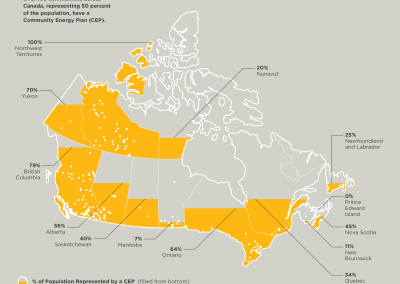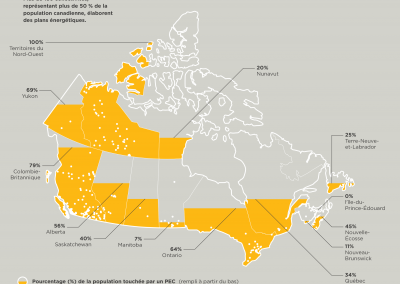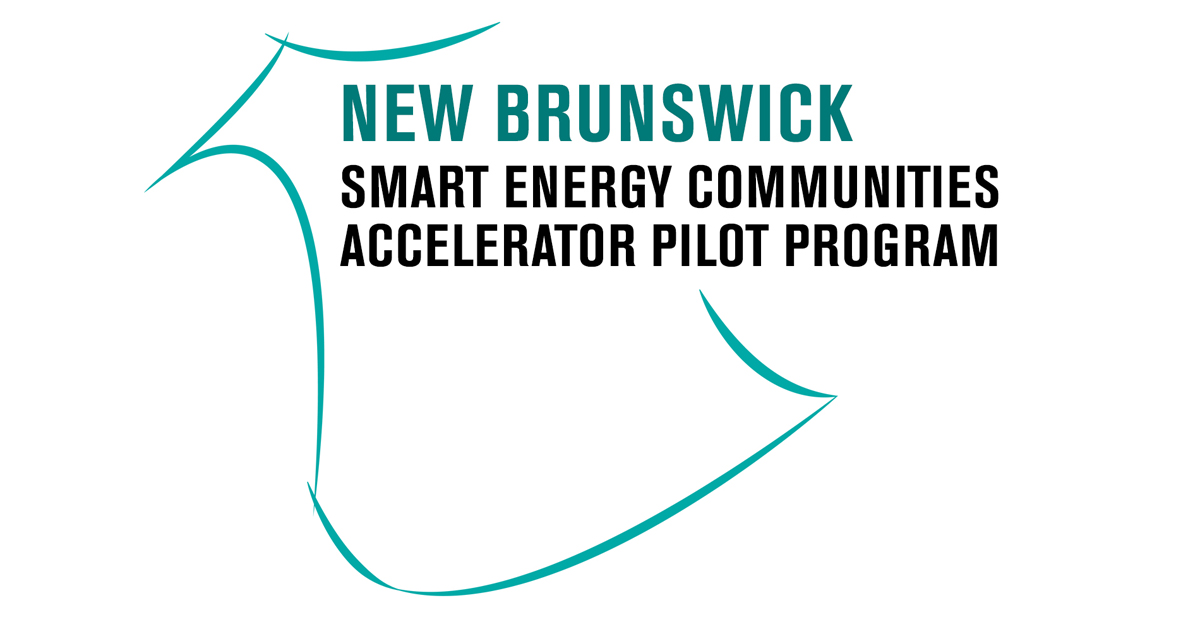Community Energy Planning
Getting to Implementation in CanadaAbout the Initiative
The Community Energy Planning Getting to Implementation in Canada Initiative was a three-year project that was completed in 2017.
A Community Energy Plan (CEP) is a tool that defines community priorities around energy with a view to improving efficiency, cutting greenhouse gas emissions, and driving economic development. While many communities in Canada are advancing Community Energy Plans (CEPs) to define priorities around energy, all communities need help getting from plans and ideas to implementation.
Project Objectives
The Getting to Implementation Initiative successfully:
- Identified the challenges and success factors for CEP implementation in Canada
- Defined business models for government staff, utilities, the real estate sector and other community stakeholders involved in implementing CEPs
- Built the capacity of CEP practitioners to implement CEPs collaboratively and effectively
- Built a community of practice focused on enhancing collaboration and mining the collective intelligence of the early adopters of CEPs in Canada
Resources
The resources developed from the Getting to Implementation Project are available here to help communities that currently have a Community Energy Plan navigate the challenges and get to implementation. They are also designed to help communities currently without a plan to design an integrated and principle-based community energy plan that optimizes the benefits and is poised for implementation.
The Community Energy Implementation Framework
Resources
The Community Energy Implementation Framework is a guide to help communities move community energy plans from a vision to implementation. It includes 10 strategies that provide insights, advice and a proposed path forward to foster widespread political, staff and stakeholder support, build staff and financial capacity, and embed energy into local plans, policies and processes to support implementation.
WHO MIGHT FIND THIS RESOURCE USEFUL?
Local government staff
Real estate developers and building managers
Elected officials at the local, provincial/territorial or federal level
Local or provincial/territorial non-governmental organizations
Electric, natural gas and thermal energy distributors
Provincial or territorial staff
The Framework
Strategy 1:
Strategy 2:
Strategy 3:
Strategy 4:
Strategy 5:
The Community Energy Implementation Framework
The Community Energy Implementation Framework is a guide intended to help communities move Community Energy Plans (CEPs) from a vision to implementation.
It includes 10 strategies that provide insights, advice and a proposed path forward to:
- Foster widespread political, staff and stakeholder support
- Build staff and financial capacity for implementation
- Embed energy into the plans, policies and processes of the local government
The Framework will answer questions such as:
- Who should lead the development and implementation of the CEP?
- What stakeholder groups should you engage with and when?
- How can you effectively communicate with various stakeholder groups to ensure meaningful engagement and input?
- What
internal and external resources are available to support CEP implementation? - How can local government staff incorporate energy into existing plans and policies?
- How can staff effectively monitor and report on implementation progress?
- And more!
What is Community Energy Planning?
Across Canada, more than 200 communities,1 representing over 50
Figure 1: Community Energy Plans across Canada
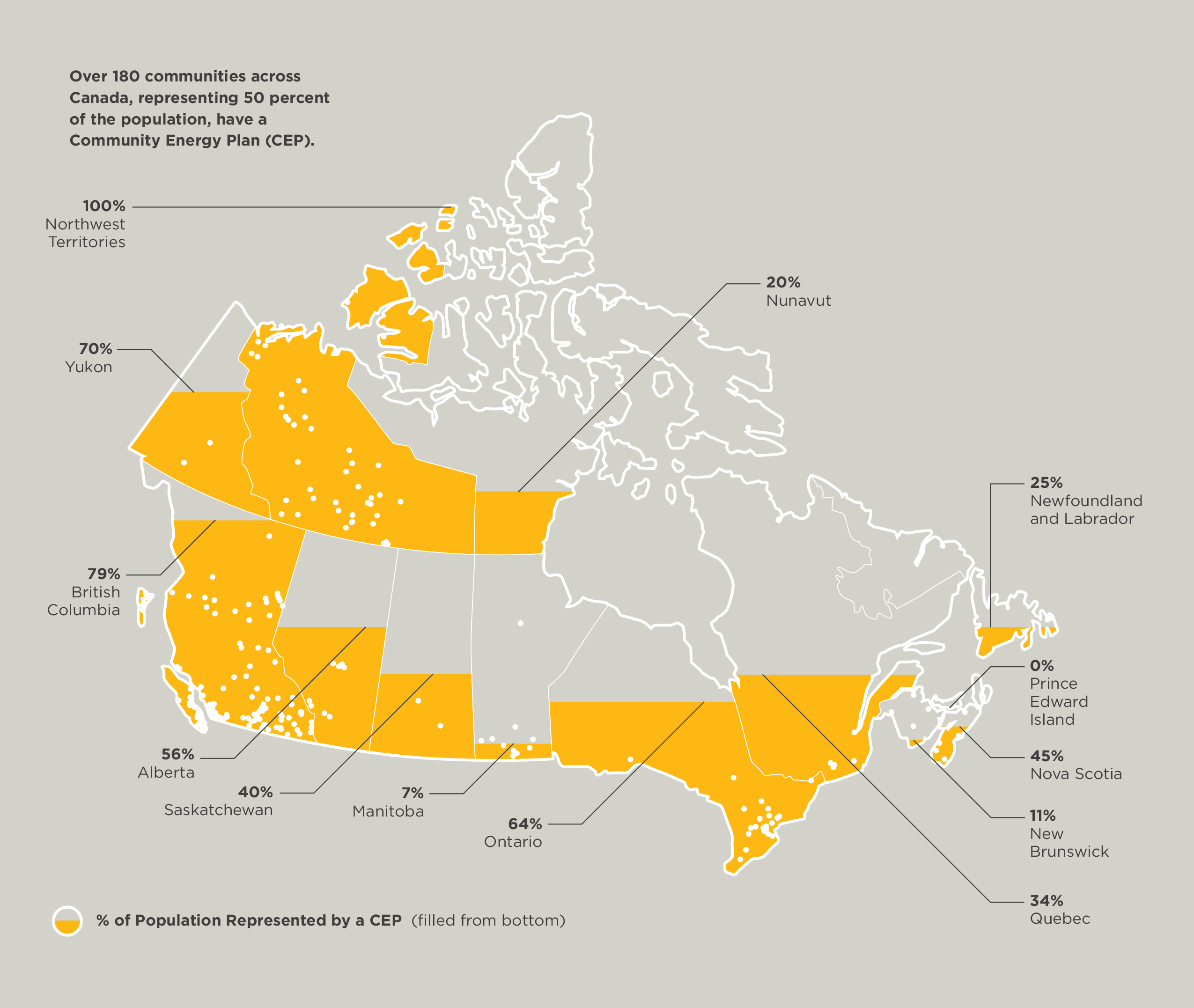
A CEP defines community priorities around energy with a view to improving energy efficiency, cutting GHG emissions, achieving resilience and driving economic development. There is growing acceptance among all levels of government, energy distributors,3 the real estate sector and other stakeholders that CEPs provide a pathway for communities to become Smart Energy Communities. Smart Energy Communities:
- Integrate conventional energy networks (electricity, natural gas, district energy, and transportation fuel) to better match energy needs with the most efficient energy source
- Integrate land use
- Harness local energy opportunities
Smart Energy Communities can be characterized by six technical and six policy principles.
The Changing Landscape of Energy in Canadian Communities
Canadian communities have an important role to play in energy. They influence nearly 60
-

Figure 2: Energy End Use in Canadian Communities
-
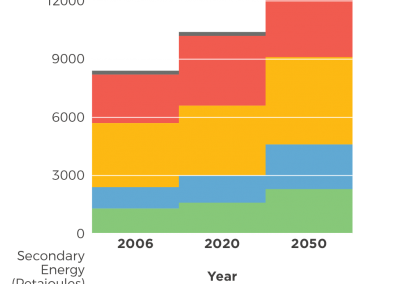
Figure 3: Potential Increase in Energy Use in Communities across Canada
Figure 4: Local Government Influence on Energy
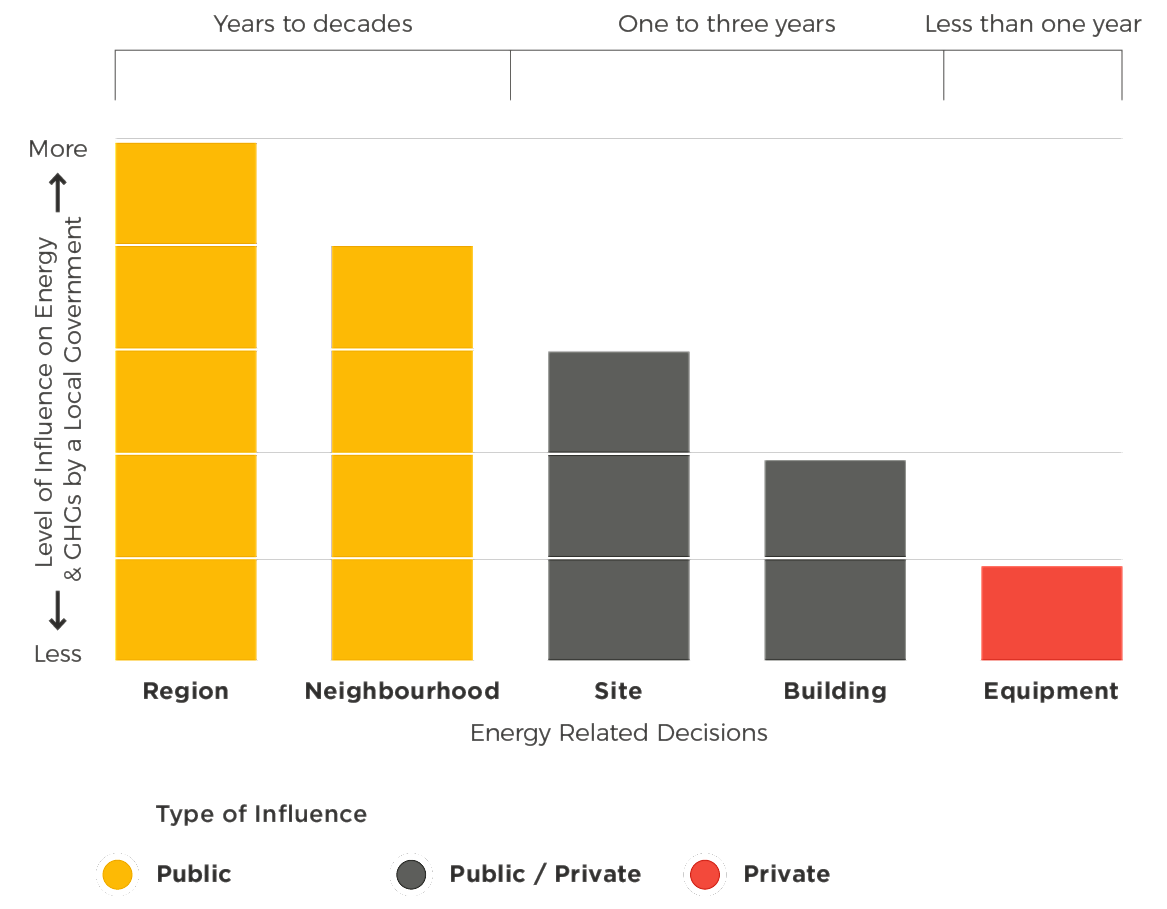
In addition to being one of the highest energy users per capita globally, Canadian communities have among some of the highest global energy costs per capita. Table 1 highlights average annual energy spending by businesses, households and governments in small, mid-sized and large Canadian communities. On average, a community of 100,000 can spend $400 million across the community on energy per year and much of that spending typically leaves the local economy.
Table 1: Annual Energy Spending in Small, Mid-sized and Large Communities11
| Community Size | Average Spending On Energy In The Community |
|---|---|
| Small Communities (less than 20,000 people) | Up to $80 million |
| Mid-sized Communities (20,000 – 100,000 people) | $40 million to $400 million |
| Large Communities (100,000 people to 2.5 million people) | $200 million to $10 billion |
Projected growth in energy consumption and the increasing costs associated with energy use are posing significant risks to Canadian communities, threatening to affect the quality of life of all Canadian residents and businesses.
Community energy planning can mitigate the risks associated with growing energy consumption and the inefficient use of energy in communities. Table 2 lists the many economic, environmental, health and resilience benefits of implementation.
Table 2: The Benefits of Community Energy Planning
| Economic benefits | Environmental benefits |
|
|
| Health and Social benefits | Resilience benefits |
|
|
There are a number of emerging opportunities supporting an energy transition in Canadian communities such as:
- Climate policy: Ambitious international, national and provincial/territorial policies are emerging in favour of a more integrated approach to energy planning. The Paris Agreement signals an unprecedented multinational agreement to raise the bar on energy and climate change action.
- Supportive policies: The Pan Canadian Framework on Climate Change presents opportunities for energy and climate action in Canadian communities. At a provincial and territorial
level there are over 640 policies, programs and regulations supporting community energy planning.13 - Urbanization: The preferences of Canadian homes and businesses are evolving. Today, 81
percent of Canadians live in urban regions, seeking improved connectivity between the places they live, work and play.14 Clean tech : There is a significant opportunity to capitalize on the globalclean tech market, which is expected to grow from $1 trillion in 2016 to $3 trillion by 2020.15
Currently, Canada’s share represents 1.3percent of the global market.16
Approaches to Community Energy Planning
Traditionally, Canadian communities have planned for buildings, transportation, land use and waste in silos. The way in which communities are planned locks in energy and emissions impacts for decades. There is an untapped opportunity to integrate buildings, transportation, land use, waste and water systems to achieve greater energy efficiency, reduce GHG emissions and drive economic development.17
Over 200 communities across Canada, representing more than 50
CEPs are often led and implemented by local governments in partnership with a broad range of community stakeholders, including energy distribution companies, the real estate sector, the private sector, NGOs and provincial/territorial governments.
CEPs often vary from community to community,
- Community-wide energy and/or GHG emissions inventories
- Energy conservation and/or GHG reduction targets, and in some cases sub-sector targets for the building, waste and transportation sectors
- Proposed community-wide actions and strategies to meet the targets, including but not limited to, energy efficiency in buildings, planning and policy measures, transportation (including public transit, active transportation, low carbon vehicles and other transportation actions), waste, distributed energy resources (including renewable energy, district energy and combined heat and power), and water conservation
- Analyses of the economic, environmental, health and social benefits of implementation
- Key Performance Indicators to allow the community to monitor and report on
implementation
CEPs also vary with respect to the level of detail contained in energy inventories as well as how deeply the economic, environmental, health and social benefits of CEP implementation are analyzed.
Table 3 describes various approaches to CEP development as well as the resources required to develop and the type of information they provide. Communities should pursue an approach that aligns with the community’s priorities, size, demographics, and available resources.
Table 3: Approaches to Community Energy Planning19
| CEP Approach | Description | Community Size | Cost | Information Provided |
|---|---|---|---|---|
| Inventory | A community energy inventory is the first step in defining community needs around energy. | Any community size | $15,000-$20,000* |
|
| Get Started | Focusing on a specific project, initiative or opportunity can often be done expediently and economically and can help garner the support needed to develop a CEP. Consider the actions listed in Figure 6 (found under “Implement a Single Energy Project“) | Any community size | Project cost |
|
| Practical Tactics | Communities with energy and emissions inventories can develop projections and a year-by-year implementation plan. This approach may include frequent involvement of elected officials, staff, and stakeholders. These plans can be renewed frequently (e.g. every 3-5 years). | 50,000 or less | $5,000-$10,000** |
|
| Targeted Plan | Larger communities can develop more comprehensive and long-term plans. This typically includes more stakeholder consultations and detailed projections. These plans can be renewed every 5-7 years. | 100,000 or more | $50,000-$150,000 |
|
| Comprehensive Plan | Communities with greater resources can include more comprehensive analyses when developing their CEP, including a broader range of energy end uses (e.g. food production). | 250,000 or more | $100,000-$250,000 |
|
The process of implementing a CEP will differ from community to community and depends on a number of factors, ranging from the community
Table 4: CEP Development and Implementation Process*
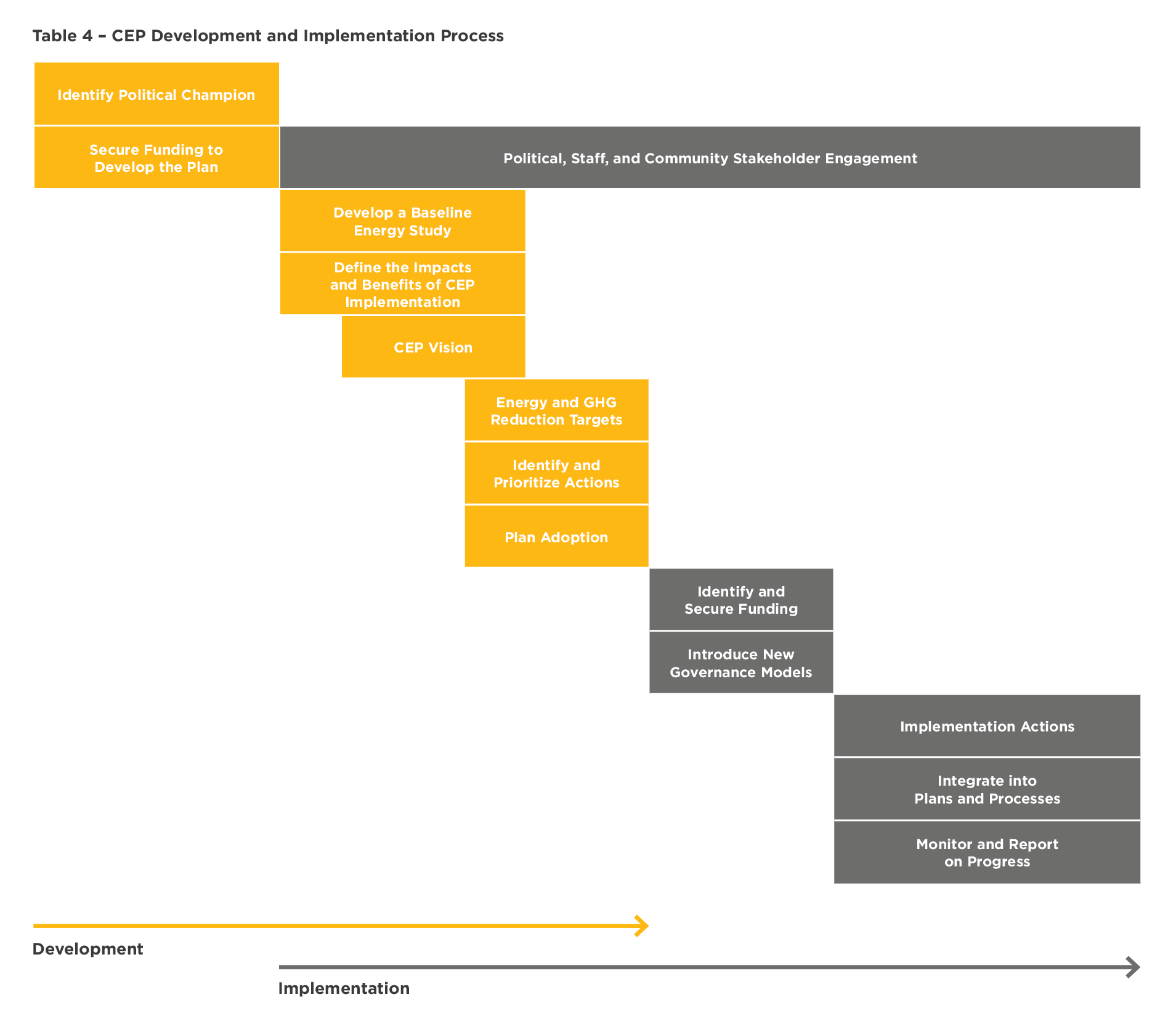
Strategy 1
Develop a Compelling Rationale for Undertaking the Community Energy Plan
Community energy planning can help mitigate risks, and has the potential to lead to widespread economic, health, social, resilience and environmental benefits. While greenhouse gas (GHG) reductions are an important part of community energy planning, it is critical to define what other benefits the CEP can generate. A critical success factor for CEP implementation is defining how the CEP will enable the community to meet its economic, environmental, health, social and resilience objectives.
GTI Advice
- Focus on the widespread benefits of CEP implementation, beyond GHGs: CEPs have the potential to lead to significant economic, health, social, resilience and environmental benefits. Be sure to describe how CEP implementation will lead to measurable benefits when describing the plan to senior management and council
- Caution against analysis paralysis: The analysis to support a CEP should only go as deep as is needed to gain support from senior decision makers and elected officials
- Be precise, yet efficient: Aim for detailed, precise and
defendable data. Consider that projections beyond 30 years have inherent limits due to technology advances, fluctuating energy prices, changing business models and cultural attitudes - Focus on actions under the jurisdiction of local government: When developing models, include business-as-usual assumptions as well as provincial and federal policies that have already been adopted. Avoid including provincial, territorial or federal policies that have not yet been adopted
- Use familiar language: Use language that resonates with the stakeholder group you are engaging
Table 5: Analyzing the Widespread Benefits of CEPs
| Summary Of Benefits | What You Will Need | Resources To Get Started | |
|---|---|---|---|
| Environmental Benefits |
|
|
|
| Economic Benefits21 |
|
|
|
| Health and Social Benefits |
|
|
|
| Resilience Benefits |
|
|
|
Methods for Measuring the Economics of Community Energy Plans
Table 6 illustrates a range of methods for measuring the economic impacts of CEPs.26
Table 6: Measuring the Economics of Community Energy Plans
| Method | Purpose | Relevant CEP Approach* |
|---|---|---|
| Community Energy Cost | Discuss total community energy use in a metric everyone understands, in order to generate different conversations with elected officials and stakeholders. |
|
| Financial Feasibility | Screen and prioritize measures, programs, or portfolios to identify if the investment will break even. |
|
| Levelized unit energy cost | Compare the unit costs of different energy generating technologies across the expected lifetime of the asset, in real dollars per kWh. |
|
| Marginal Abatement Cost Curve | Compare GHG emission reduction options according to which will cost the least or deliver the most financial savings, and according to their potential impact on GHG reductions. |
|
| Community economic benefits | Inform the decision-making process, and stakeholders, on the total value to the local economy of a CEP, considering the how direct expenditures recirculate through local businesses, households, and tax revenue. |
|
| Screen and prioritize measures, programs, or portfolios to identify if benefits over time exceed initial |
|
Relevant Resources
Case Study 15: Net Zero Community in London, Ontario
West Five (www.west5.ca) is a 70 acre, mixed-use site located in London, Ontario. The site is being developed by Sifton Properties, in partnership with S2E Technologies. When completed, the neighbourhood will include 2,000 residential units, commercial and retail space, and parkland. The development will include a number of Smart Energy Community Principles,89 including energy efficient buildings (e.g. the use of enhanced insulation), the use of renewable energy resources (e.g. solar shingles) and matching land use needs and mobility options (e.g.
Read the Community Energy Knowledge Action Partnership case study here.
Case Study 17: Monitoring and Reporting on CEP Implementation in the City of London, Ontario
The City of London Community Energy Action Plan (CEAP) was adopted in 2014. Alongside the plan, the City of London developed a background document describing a methodology for monitoring and reporting on community energy use. The background document describes a methodology for developing annual energy and emissions inventories. The document describes how the City of London will also work with stakeholders to develop new Key Performance Indicators, including economic, transportation, and energy performance indicators. The results from energy and emissions inventories, and other Key Performance Indicators will be included in an annual progress report outlining implementation progress of the CEAP.90
Strategy 2
Collaborate with a Political Champion and Engage Council
Council support is critical for implementation, as it provides direction, inspiration and impetus for local government staff, and the community, to prioritize community energy planning. Communities that take the time to engage with a political champion and council on an ongoing basis may be better positioned to move forward on implementation. Early engagement can help to surface key questions, considerations and possible challenges and can guide the CEP implementation team to focus on the aspects of the plan that matter most to the community.
Consider the following when engaging with political champions and elected officials, including when to engage them, why to engage them and how to engage them.
Collaborating with Political Champions
| Who to engage | When to engage them |
|
|
| Why engage them | How to engage them and what to focus on |
|
|
Building Widespread Support from Elected Officials
| Who to engage | When to engage them |
|
|
| Why engage them | How to engage them and what to focus on |
|
|
Relevant Resources
Case Study 2: Measuring the Widespread Economic Benefits in the City of London, Ontario
The City of London, Ontario has conducted an economic analysis to measure various economic impacts and potential benefits of implementing their Community Energy Action Plan (CEAP). The analyses, conducted in-house, demonstrate community-wide energy spending, the proportion of energy spending leaving the local economy and the potential to recirculate energy spending based on the implementation of their plan.
The approach
- Energy spending analysis
Video supporting energy spending analysis: Turning energy data into energy dollars- The City of London has also produced infographics based on the analyses, available here
Case Study 3: Measuring Green Jobs in Durham Region, Ontario
The Region of Durham Community Climate Change Local Action Plan highlights the estimated environmental, economic and social impacts of implementation. The plan is available
Case Study 4: Measuring the Impacts of Sustainable Communities on Local Retail Sales New York City, New York
The New York City Department of Transportation created a methodology for measuring the economic impacts of improved streetscapes and active transportation infrastructure on retail sales. The study is available here: New York City Department of Transportation (December 2013). The Economic Benefits of Sustainable Streets.
Case Study 5: Framing the Value Proposition, Edmonton, Alberta
There is a lesson to be learned in how Edmonton’s Sustainable Development Department communicated the need for the strategy. First, it was framed as a risk management strategy designed to protect Edmonton’s quality-of life from climate and energy risks. Secondly, it provided a compelling economic business case involving ten community-scale programs (for advancing energy conservation, energy efficiency and renewable energy uptake) that would deliver a net public benefit of $3.3 billion over 20 years.
Case Study 21: Integrated Financial Planning in the City of Coquitlam, British Columbia
Coquitlam’s award-winning integrated financial planning framework is comprised of three separate but complementary planning processes. These processes result in a set of integrated plans that support the overall vision and mission of the City and align activities and resources to achieve the strategic goals and annual business plan priorities set by Council.
- Council’s Strategic Plan – aspirational, future-looking plan, updated every four years following the municipal election. It articulates the vision, mission, values and broad strategic goals.
Progress of the plan is monitored through an annual review of key performance measures and accomplishments - Business Plan – translates the
high level strategic goals into annual business plan work items and priorities, established by Council. A set of performance measures are reviewed annually to monitorsuccess of the business plan - Financial Plan – provides the resourcing strategy to support the strategic and business plans. Updated annually, it is a five-year plan that includes both operating and capital components
Evaluation of achievements informs the next cycle of planning. For example, the City’s performance is reviewed every four months with a Trimester Report to Council. It includes an update on the progress of the work items under the Business Plan priorities and a review of operating and capital budget variances, labour vacancies, economic indicators including construction and development activities, and major spending during the trimester. The intent of the report is to view the City’s activities and progress balanced with the status of the City’s financial and human resources.
In this model, it is important that staff responsible for developing and implementing the CEP ensure that its goals and actions are reflected in Council’s (strategic) plan and that these goals and actions maintain a high profile throughout the budgeting/financial plan process.
See the Strategic Plan here: City of Coquitlam (2012). 2012-2015 Strategic Plan.
Strategy 3
Develop a Governance Model that Supports a Community Energy Transition
New governance models provide a platform for political, staff and community stakeholders to convene regularly. In some cases, they provide the legal framework needed to implement projects. This can ensure that a process is in place to monitor and report regularly on the implementation of the CEP.
GTI Advice
- Ensure that there is a clear purpose for new committees or governance structures
- Determine if the objective can be accomplished within existing committee structures or if a new structure should be introduced
- Consider that new, dedicated committees will ensure that the CEP remains at the forefront for elected officials, staff and community stakeholders
- Ensure that the governance structure involves all political, staff and community stakeholders in a constructive dialogue, and ensure they feel that their contribution is valued and supported
- Ensure that the CEP progress is monitored regularly and reported back to all stakeholders annually. See Strategy 8: Monitor and Report on CEP Implementation for more information
- Ensure that committee members, particularly those who are attending on a volunteer basis, are not overworked through the number of meetings or tasks
- There is no “one size fits all” solution for communities. Choose a structure that works for your community
Table 7 provides a list of governance models to consider to support implementation at the council, staff and stakeholder levels. The table below is non-exhaustive, and communities should consider implementing governance frameworks for each of the tiers involved in the CEP (council, staff and stakeholders).
Table 7: Governance Models to Support CEP Implementation
· A community-wide committee should be formed to maintain ongoing support for CEP implementation activities.
· The committee should meet on an ongoing basis.
· The committee can include a Council representative but this may be informal
· Staff may attend meetings as a resource but generally not be members
· Meeting minutes would not usually be reported to Council in a formal way
· Meetings would be open to the public, by nature of the committee
· See Strategy 7: Engage community stakeholders and recognize their implementation progress.
| Options | Primary Tasks and Considerations |
|
Committee of Council
Mayor’s Task Force
|
|
| STAFF-LEVEL | |
|
Dedicate Staff to Manage CEP Implementation
|
|
|
Staff Advisory Committee
|
|
|
Staff Committee
|
|
|
Corporate Energy Manager
|
|
|
Community Steering/Advisory Committee
|
|
Relevant Resources
- FCM – Passing Go: Moving Beyond the Plan
- Clarke, A., MacDonald, A. & Ordonez-Ponce, E. (forthcoming). Implementing Community Sustainability Strategies through Cross-Sector Partnerships: Value Creation for and by Businesses. In: Borland, H.,
Lindgreen , A., Vanhamme, J., Maon, F., Ambrosini, V. & Palacios Florencio, B. Business Strategies for Sustainability: A Research Anthology. London, UK: Routledge.(View pre-publication version) - Clarke, A. & Ordonez-Ponce, E. (2017). City Scale: Cross-Sector Partnerships for Implementing Local Climate Mitigation Plans. Climate Change and Public Administration. Public Administration Review.
Case Study 6: Establishing a Committee of Council in Yellowknife, Northwest Territories
The Community Energy Planning Committee was established by City Council on September 10, 2007, following the completion of the Community Energy Plan (CEP).79 The Committee is chaired by the Mayor and includes representatives from across the Community. The primary purpose of the Committee is to assist the City of Yellowknife in an advisory capacity to ensure the CEP is implemented and evolves in an effective manner. The scope of the Committee is to report and make recommendations to City Council through the appropriate
Case Study 7: Establishing a Governance Framework for Edmonton’s Community Energy Transition Strategy, Edmonton, Alberta
Edmonton City Council formed an Energy Transition Advisory Committee.81 Committee members serve
Case Study 8: Stakeholder Engagement in the City of Kelowna, British Columbia
In 2012, the City of Kelowna adopted a Community Climate Action Plan containing 87 actions to be implemented by 2020. Of those actions, 59 were assigned to the local government and 28 were assigned to community stakeholders, including utilities, provincial government and others. In an effort to ensure that community stakeholders understood their roles in the implementation of the plan, the City of Kelowna circulated letters to the organizations responsible for implementing actions in the plan. These letters enabled the City of Kelowna to move forward on implementing actions that are not within its jurisdiction.82
Case Study 9: Stakeholder Engagement in Markham, Ontario
In 2014, the City of Markham began to develop a Municipal Energy Plan (MEP). As part of the MEP, the City created a Stakeholder Working Group.83
The desired outcome of the Stakeholder Working Group is to provide recommendations and feedback on the development of Markham’s MEP including:
- Identifying energy opportunities and solutions to increase local energy production and conservation
- Identifying synergies between industry stakeholders to implement MEP recommendations
See the Municipal Energy Plan Stakeholder Working Group Terms of Reference here.
See the list of stakeholders participating in the MEP Stakeholder Working Group here.
Strategy 4
Determine which Department and Staff Person(s) will Oversee CEP Implementation.
The department in which a CEP sits can significantly impact implementation. For example, a CEP can be led by the planning, community development or the economic development department. CEPs may also be led by local NGOs or by the provincial/territorial government.
Consider the following questions:
- What department (or organization) should oversee the CEP?
- What
staff person should act as the lead for CEP development and implementation?
What Department (Or Organization) Should Oversee The CEP?
- Recognizing that collaboration and coordination among political, staff and community stakeholders is central for community energy planning, the department in which a CEP is housed should be well-positioned to communicate and liaise with political, staff and community stakeholders
- The department should be well-positioned to communicate the widespread economic, environmental, health, social and resilience benefits of CEP implementation.
- CEPs are often housed within the planning department due to the strong links that community energy holds with planning and development.
- Some communities house their CEP in the economic development department, recognizing the strong link between economic growth and community energy transition
- In some cases the following types of organizations may be well-suited to lead CEP development and implementation:
- A local NGO organization with a mandate related to community energy
- Regional government, if applicable
Territorial /provincial government, particularly for rural and remote communities
What Staff Person Should Act At The Lead For CEP Development And Implementation?
- The CEP will have significantly more
success if there is a dedicated staff person overseeing CEP development and implementation. Without a dedicated staff person, implementation often falls to the sides of many desks and eventually loses momentum. Assign a dedicated staff person to oversee implementation, such as a Community Energy Manager, Planner or an Economic Development Officer. The staff person should have adequate capacity to manage oversight of the CEP - A staff person that sits at a management level is often well-suited to oversee CEP development and implementation. A manager remains equally as close to senior management/council as it does to staff and stakeholders working to implement the plan on the ground. If this is not possible, try to appoint a staff person with the ability to communicate and liaise with political, staff and community stakeholders, and who possesses some of the knowledge, skills and academic credentials listed below
Skills and Credentials for CEP Implementation
Knowledge and Skills of the Designated Staff Person
- Communication
- Stakeholder and community engagement
- Project management and facilitation
- Research and writing
- Energy literacy
- Change management
- Leadership
- Strategic planning
- Familiarity with local government processes and legislation
- Policy and program development
- Sustainability practices
- Quantitative data analyses (spreadsheet software)
- Mapping (geographical information system software)
- Business case development
- Feasibility/financial analysis
Academic Credentials and Certifications32
- Degree in planning, public policy, engineering, sustainability, environmental science, resource management, business
- Degree, diploma or certificate in communication
- Registered Professional Planner / Member of the Canadian Institute of Planners
- Registered Professional Engineer
- Certified Community Energy Manager (CCEM)
- Certified Energy Manager (CEM)
- Registered Engineering Technologist
- LEED Professional Accreditation (LEED AP)
- Project Management Professional (PMP)
Consider Developing the CEP at a Different Scale.
While CEPs are often led by a local government, they do not have to be. CEPs can be developed at different scales, for example at a regional or neighbourhood scale. Developing a CEP at an alternative scale may be an effective approach for your community if:
- You are a small community with
little capacity to develop a CEP - You are a large community whereby a CEP may not be an effective way to meet the highly varying needs across the community
- You live within the jurisdiction of a regional government and can find efficiencies by coordinating among communities in the region
How to Get Started
- Refer to Appendix IV – Provincial/Territorial Municipal Organizations that may have Community Energy Planning Resources. Many organizations across Canada provide community energy planning support and can connect communities with the resources or contacts needed to get started
- Consider reaching out to local government staff, regional government staff or neighbouring communities as well as local energy distributors, to begin discussions about possible models for community energy planning
- Consider that many local energy distributors or provincial/territorial governments provide or match funding to support the development and implementation of a CEP
- Consider risks associated with staff turnover and attrition. Many communities, and most often rural and remote communities, face high staff turnover. High staff turnover can lead to a fragmented implementation process and the loss of relationships and corporate knowledge with respect to implementation. In addition, all communities face the risk of losing corporate knowledge as a result of staff attrition
- Consider the approaches listed in Strategy 3: Develop a Governance Model that Supports a Community Energy Transition. The focus of this strategy is to embed the CEP within the processes of the local government and focus on building a network of champions, and redundancy in staff involvement in the CEP
- If possible, provide incentives to reduce staff turnover, such as:
- Provide professional development opportunities such as training programs
- Offer frequent formal and informal recognition and/or awards based on performance to improve employee morale and motivation
- Provide employee engagement opportunities to improve employee contentment and loyalty
- Sometimes, corporate knowledge may lie with a contractor that has been retained for community energy planning consulting services for the community. Consider engaging or re-engaging with former consultants if your community is facing a loss of internal corporate knowledge about previous efforts related to the CEP
Relevant Resources
Case Study 6: Establishing a Committee of Council in Yellowknife, Northwest Territories
The Community Energy Planning Committee was established by City Council on September 10, 2007, following the completion of the Community Energy Plan (CEP).79 The Committee is chaired by the Mayor and includes representatives from across the Community. The primary purpose of the Committee is to assist the City of Yellowknife in an advisory capacity to ensure the CEP is implemented and evolves in an effective manner. The scope of the Committee is to report and make recommendations to City Council through the appropriate
Case Study 7: Establishing a Governance Framework for Edmonton’s Community Energy Transition Strategy, Edmonton, Alberta
Edmonton City Council formed an Energy Transition Advisory Committee.81 Committee members serve
Case Study 16: Monitoring and Reporting on Implementation Progress in the City of Guelph, Ontario
CEP reporting is coordinated annually by the Community Energy division of the Business Development and Enterprise department, and presented to the Corporate Administration, Finance & Enterprise Committee (this Committee is appointed by Council and made up of Councillors). A dashboard is used to display progress within eight key activity categories, plus a description of the status for each individual activity.
See the Guelph Community Energy Plan here.
Case Study 18: Efficiency One, Nova Scotia
Efficiency One in Nova Scotia, formerly Efficiency Nova Scotia, has provided on-site energy managers for organizations such as Cape Breton University, Capital District Health Authority, Dalhousie University and Nova Scotia Community College. These embedded energy managers help to identify and coordinate projects to achieve substantial energy efficiency savings. For example after first six months of the partnership between Efficiency One and Capital Health in 2012, several projects were initiated totalling savings of $118,000 per year.91
Case Study 19: Community Energy Planning Alternatives for Small Communities – Eco-Ouest
Eco-Ouest, led in partnership with CDEM, SSD, has developed a program designed to help provide expertise to smaller municipalities in Manitoba, Saskatchewan and Alberta that face resource and capacity constraints for CEP development and implementation. Eco-Ouest has partnered with rural municipalities in each of these provinces to create energy and GHG emissions inventories and Climate Change Local Action Plans such as the inventory for the Rural Municipality of St. Clements and plans for the Rural Municipality of Saint-Laurent and Rural Municipality of Taché. CDEM also incorporates a regional perspective by comparing neighbouring communities’ energy and emissions performances and sharing successful projects and case studies.92CDEM. (n.d.). Eco-West. Retrieved from CDEM Website
Case Study 20: Yukon Energy Solutions Centre
The Yukon Energy Solutions Centre is part of the Energy branch in the Government of Yukon Department of Energy, Mines and Resources.
The Energy Solutions Centre offers community-level energy services to such as:
- Providing technical information and financial incentives to encourage the use of energy efficient appliances and heating systems at the local level
- Providing comprehensive energy planning services, including energy baseline assessments and policy reviews
- Providing training courses to build local technical capacity to implement community energy plans and projects
- Participating in outreach and public education on the health, safety, economic and environmental benefits of energy efficiency and renewable energy
To learn more about the Energy Solutions Centre visit http://www.energy.gov.yk.ca/about-the-energy-branch.html
Strategy 5
Engage Staff across the Local Government. Identify Staff Champions and Embed the CEP into Staff Job Descriptions
CEPs cross many departmental boundaries and consequently require early and ongoing inter-departmental coordination and collaboration. The following non-exhaustive list of local government departments should be involved in the development and implementation of the CEP.
- Land use planning
- Transportation
- Economic development
- Finance
- Chief Administrative Officer
- Engineering/public works
- Public health
- Environment/sustainability
- Communications
- Global Information Systems
- Others as needed
Engagement should take place at the senior management and junior/intermediate staff level. Table 8 provides a snapshot of how some of the actions within a CEP relate to various departments. This is intended to act as a starting point for determining which aspects of the CEP are relevant for which departments.
Table 8: Local Government Department Roles in CEP Implementation
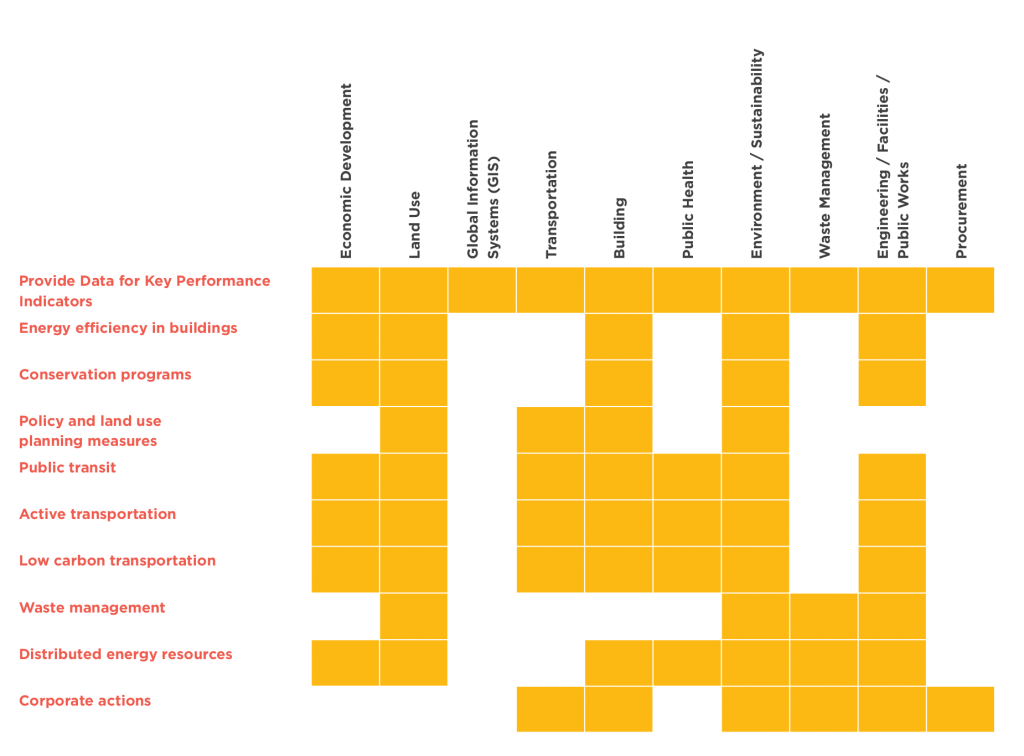
Engaging Senior Management from All Departments
Consider the following GTI Advice on how to engage with senior staff.
| Who to engage | When to engage them |
|
|
| Why engage them | How to engage them and what to focus on |
|
|
Engaging Other Departments including but not limited to Planning, Transportation, GIS, Public Works and Parks and Recreation
Consider the following GTI Advice on how to engage with staff within the local government.
| Who to engage | When to engage them |
|
|
| Why engage them | How to engage them |
|
|
Engaging the Finance Department
Consider the following GTI Advice on how to engage with staff within the finance department.
| Who to engage | When to engage them |
|
|
| Why engage them | How to engage them |
|
|
Embed the CEP into Staff Job Descriptions
Once staff across the municipality are engaged, amend existing and new job descriptions to include CEP considerations.
Include tasks for all positions responsible for implementing local government plans, including department heads in the above-listed departments. While the level of responsibility and tasks will vary according to the position, consider the following language as a starting point:
“The incumbent performs a variety of routine and complex technical work … including supporting the development and implementation of the Community Energy Plan.”
Relevant Resources
Case Study 1: CEP Renewal in the City of Yellowknife, Northwest Territories
The City of Yellowknife adopted a CEP in 2006. With a target year of 2014, Yellowknife aimed to reduce its corporate GHG emissions by 20 per cent and its community GHG emissions 6 per cent, based on 2004 levels. It budgeted $500,000 annually for energy efficiency, renewable energy conversions and public awareness. By February 2013, the City surpassed its target and the projects implemented now save the City an estimated $528,000 per year.76
One of the last steps initiated during the implementation of the CEP was the adoption of a renewal process for the plan. This renewal process included the development of a strategy for public and community stakeholder engagement to support the creation of a CEP for 2015-2025. Yellowknife has since embarked on a process where a new assessment of the Community’s GHG emissions will be completed and new targets will be established.
Case Study 6: Establishing a Committee of Council in Yellowknife, Northwest Territories
The Community Energy Planning Committee was established by City Council on September 10, 2007, following the completion of the Community Energy Plan (CEP).79 The Committee is chaired by the Mayor and includes representatives from across the Community. The primary purpose of the Committee is to assist the City of Yellowknife in an advisory capacity to ensure the CEP is implemented and evolves in an effective manner. The scope of the Committee is to report and make recommendations to City Council through the appropriate
Case Study 7: Establishing a Governance Framework for Edmonton’s Community Energy Transition Strategy, Edmonton, Alberta
Edmonton City Council formed an Energy Transition Advisory Committee.81 Committee members serve
Case Study 12: City of Yellowknife Community Energy Plan Communications Plan, Northwest Territories
The City of Yellowknife Community Energy Plan Communications Plan describes a detailed approach for engaging with the public.86 At the core of the plan, there is a recognition that in order to reduce GHG emissions across the community, Yellowknife residents and businesses must change current energy use practices. This requires a shift in awareness, attitudes and
Strategy 6:
Strategy 7:
Strategy 8:
Strategy 9:
Strategy 10:
Appendices
Strategy 6
Define How the CEP will Generate Value for Community Stakeholders
While CEPs are often led by local governments, they are implemented by the community. Early and meaningful collaboration and coordination with community stakeholders is critical for fostering buy-in, ownership and accountability for implementation.
Before engaging with stakeholders, it may be helpful to identify ways in which the CEP can add value to their business models. Some of the stakeholders most central to the success of the CEP include:
- Electric, natural gas and thermal energy distributors
- The real estate sector (including developers, homebuilders, building owners and operators, architects, and real estate agents)
- Provincial/territorial government
- Large energy users in the industrial commercial and institutional sector
- NGOs
The value of community energy planning to each of these stakeholders is described in the following subsections.
Other stakeholders to engage include, but are not limited to:
- Local chambers of commerce
- School boards
- Fuel suppliers
- Engineering and planning consultants
- Other local governments
- The public
- Others
Engaging Energy Distributors
Electricity, natural gas and thermal energy distributors are critical partners for CEP development and implementation as they have technical expertise in managing infrastructure and experience delivering programs and building projects.
- The business models of energy distributors are evolving. Some of the factors influencing this shift include, but are not limited to:
- The introduction of ambitious conservation targets
- The installation of smart meters in several jurisdictions and resulting data and IT management
- Increased adoption of new technologies, including distributed energy resources and alternative fuel vehicles, as well as the introduction of policies encouraging their uptake
Table 9 summarizes how a CEP can add value to the evolving business models of energy distributors.
Table 9 – The Value Proposition of Community Energy Planning to Energy Distributors
| Considerations | CEP Value |
|
|
|
|
|
|
|
|
|
|
Consider the following when engaging with the energy distributors.
| Who to engage | When to engage them |
|
|
| Why engage them | How to engage them |
|
What the CEP can provide:
What is required from distributors for the CEP:
|
|
Engaging the Real Estate Sector
Business models within the real estate sector are evolving. Some of the factors influencing this shift include, but are not limited to:
- The evolving preferences of home buyers and businesses. There is a growing mismatch between the high demand for energy efficiency buildings and homes and the supply. Similarly, there is a growing demand for compact, mixed-use neighbourhoods and communities
- Increasing concerns from building owners and operators about the growing cost of energy as a proportion of overall building operating costs
- Federal, provincial and territorial policies evolving in favour of energy efficiency, integrated land use and transportation and distributed energy resources
- Significant, untapped opportunities for integrating distributed energy resources into building design
These changes have impacts on real estate developers, building owners and operators, architects and real estate agents and while some organizations are taking the lead when it comes to community energy projects, many have yet to catch up. Table 10 summarizes some of the realities the real estate sector is facing and describes how participating in the community energy planning process can add value to their business models.
Table 10 – The Value Proposition of Community Energy Planning to the Real Estate Sector
| Real Estate Sector Factors | CEP Value |
|
|
|
|
|
|
|
|
Consider the following when engaging with the real estate sector.
| Who to engage | When to engage them |
|
|
| Why engage them | How to engage them |
|
|
Engaging Provincial and Territorial Governments
Provincial and territorial governments are essential in the community energy planning process:
- Increasingly, provincial and territorial governments and their respective agencies are placing a growing emphasis on energy and emissions.39 Community energy planning offers a platform to achieve deep energy and GHG reductions while facilitating economic growth and can directly help achieve provincial and territorial objectives
- Health care costs represent a large, and increasing portion of most provincial/territorial budgets and community energy planning can help to reduce these costs
- They also oversee policies and programs that may impact or be impacted by community energy planning.
- They may also have
technical expertise needed for CEP development and implementation - They may have energy
end use data and - Key Performance Indicator data needed to monitor implementation progress
Consider the following when engaging with provincial and territorial governments.
| Who to engage | When to engage them |
|
|
| Why engage them | How to engage them |
|
What provincial/territorial governments may need from communities:
What communities may need from provincial/territorial governments:
|
|
Engaging Non-Governmental Organizations
| Who to engage | When to engage them |
|
|
| Why engage them | How to engage them |
|
|
Engaging the Public
CEP implementation requires residents and businesses to change the way they consume energy. But when and how should the public be engaged, and what for?
- While the CEP should be undertaken with the public interest in mind, public engagement may not be needed before a CEP is developed
- Public engagement may be most effective once programs have been developed, whereby targeted educational materials and calls to action can be presented to residents and businesses
- Engagement is often most powerful when you go to the community, instead of waiting for the community to come to you. There are many tried and tested alternatives to public engagement meetings
- When communicating with the public, emphasize person benefits such as cost savings
- Use visually compelling materials such as infographics and energy maps41
- Engage youth to solicit ideas for change. Engage students to act as ambassadors for the CEP
Relevant Resources
- National Report on Community Energy Plan Implementation
- National Report on Policies Supporting Community Energy Plan Implementation
- Community Energy Planning: The Value Proposition
- Policies to Accelerate Community Energy Plans: An analysis of British Columbia, Ontario and the Northwest Territories
- Canada Green Building Council Municipal Green Building Toolkit
- Vancouver Island Real Estate Energy Efficiency Program
Case Study 2: Measuring the Widespread Economic Benefits in the City of London, Ontario
The City of London, Ontario has conducted an economic analysis to measure various economic impacts and potential benefits of implementing their Community Energy Action Plan (CEAP). The analyses, conducted in-house, demonstrate community-wide energy spending, the proportion of energy spending leaving the local economy and the potential to recirculate energy spending based on the implementation of their plan.
The approach undertaken and resources are available here:
- Energy spending analysis
- Video supporting energy spending analysis: Turning energy data into energy dollars
- The City of London has also produced infographics based on the analyses, available here
Case Study 3: Measuring Green Jobs in Durham Region, Ontario
The Region of Durham Community Climate Change Local Action Plan highlights the estimated environmental, economic and social impacts of implementation. The plan is available
Case Study 4: Measuring the Impacts of Sustainable Communities on Local Retail Sales New York City, New York
The New York City Department of Transportation created a methodology for measuring the economic impacts of improved streetscapes and active transportation infrastructure on retail sales. The study is available here: New York City Department of Transportation (December 2013). The Economic Benefits of Sustainable Streets. http://www.nyc.gov/html/dot/downloads/pdf/dot-economic-benefits-of-sustainable-streets.pdf
Case Study 5: Framing the Value Proposition, Edmonton, Alberta
The City of Edmonton, Alberta (population 812,000) adopted Edmonton’s Community Energy Transition Strategy in April 2015 and a corresponding City Policy C585 in August 2015.78 The Strategy, which represents a renewal and upgrade of their 2001 plan, was approved unanimously by City Council. Based on extensive citizen consultation, the strategy includes twelve strategic courses of action and an eight-year action plan with more than 150 tactics.
There is a lesson to be learned in how Edmonton’s Sustainable Development Department communicated the need for the strategy. First, it was framed as a risk management strategy designed to protect Edmonton’s
Case Study 6: Establishing a Committee of Council in Yellowknife, Northwest Territories
The Community Energy Planning Committee was established by City Council on September 10, 2007, following the completion of the Community Energy Plan (CEP).79 The Committee is chaired by the Mayor and includes representatives from across the Community. The primary purpose of the Committee is to assist the City of Yellowknife in an advisory capacity to ensure the CEP is implemented and evolves in an effective manner. The scope of the Committee is to report and make recommendations to City Council through the appropriate
Case Study 7: Establishing a Governance Framework for Edmonton’s Community Energy Transition Strategy, Edmonton, Alberta
Edmonton City Council formed an Energy Transition Advisory Committee.81 Committee members serve
Case Study 8: Stakeholder Engagement in the City of Kelowna, British Columbia
In 2012, the City of Kelowna adopted a Community Climate Action Plan containing 87 actions to be implemented by 2020. Of those actions, 59 were assigned to the local government and 28 were assigned to community stakeholders, including utilities, provincial government and others. In an effort to ensure that community stakeholders understood their roles in the implementation of the plan, the City of Kelowna circulated letters to the organizations responsible for implementing actions in the plan. These letters enabled the City of Kelowna to move forward on implementing actions that are not within its jurisdiction.82
Case Study 9: Stakeholder Engagement in Markham, Ontario
In 2014, the City of Markham began to develop a Municipal Energy Plan (MEP). As part of the MEP, the City created a Stakeholder Working Group.83
The desired outcome of the Stakeholder Working Group is to provide recommendations and feedback on the development of Markham’s MEP including:
- Identifying energy opportunities and solutions to increase local energy production and conservation
- Identifying synergies between industry stakeholders to implement MEP recommendations
See the Municipal Energy Plan Stakeholder Working Group Terms of Reference here.
See the list of stakeholders participating in the MEP Stakeholder Working Group here.
Case Study 11: Public Engagement on Community Energy in London, Ontario
The City of London, Ontario has documented public engagement efforts in a document entitled Learning from People: A Background Document for the Community Energy Action Plan: https://www.london.ca/residents/Environment/Energy/Documents/Learning_from_People.pdf
As part of the development of the Community Energy Action Plan, the City of London undertook a campaign called ReThink Energy London. The City of London held a Community Energy Strategy Workshop and the London Roundtable on the Environment and the Economy to inform the development of the Community Energy Action Plan. Community Energy Strategy Workshop included an interactive energy mapping exercise that involved 31 participants from electrical, natural gas and thermal utilities, internal departments, environmental and transportation advisory committees and provincial staff, among other stakeholders. The city’s energy map was used to help stakeholders identify energy opportunities and risks, and to generated ideas and principles for energy actions in key areas such as buildings, transportation and low carbon energy generation in the City of London. Outcomes from the workshop can be found here: https://www.london.ca/residents/Environment/Climate-Change/Documents/London_FINALSummaryofWorkshop_May11.pdf
Case Study 12: City of Yellowknife Community Energy Plan Communications Plan, Northwest Territories
The City of Yellowknife Community Energy Plan Communications Plan describes a detailed approach for engaging with the public.86 At the core of the plan, there is a recognition that in order to reduce GHG emissions across the community, Yellowknife residents and businesses must change current energy use practices. This requires a shift in awareness, attitudes and
Case Study 13: Fort Providence, Northwest Territories
In 2007 and 2008 the community of Fort Providence, Northwest Territories (population 735), in partnership with the Arctic Energy Alliance, developed an energy profile.87
The objective of this exercise was to provide the community, and key decision makers, with a snapshot of energy use in the community.
The energy profile was developed to communicate a large quantity of energy data, including energy consumption, energy end use, cost of energy, and GHG emissions. Similar to any community that looks at energy use and costs per capita, the energy profile revealed significant opportunities to conserve energy and improve efficiency within the community.
Case Study 19: Community Energy Planning Alternatives for Small Communities – Eco-Ouest
Eco-Ouest, led in partnership with CDEM, SSD, has developed a program designed to help provide expertise to smaller municipalities in Manitoba, Saskatchewan and Alberta that face resource and capacity constraints for CEP development and implementation. Eco-Ouest has partnered with rural municipalities in each of these provinces to create energy and GHG emissions inventories and Climate Change Local Action Plans such as the inventory for the Rural Municipality of St. Clements and plans for the Rural Municipality of Saint-Laurent and Rural Municipality of Taché. CDEM also incorporates a regional perspective by comparing neighbouring communities’ energy and emissions performances and sharing successful projects and case studies.92CDEM. (n.d.). Eco-West. Retrieved from CDEM Website: http://www.cdem.com/en/sectors/green-economy-1/eco-west
Case Study 20: Yukon Energy Solutions Centre
The Yukon Energy Solutions Centre is part of the Energy branch in the Government of Yukon Department of Energy, Mines and Resources.
The Energy Solutions Centre offers community-level energy services to such as:
- Providing technical information and financial incentives to encourage the use of energy efficient appliances and heating systems at the local level
- Providing comprehensive energy planning services, including energy baseline assessments and policy reviews
- Providing training courses to build local technical capacity to implement community energy plans and projects
- Participating in outreach and public education on the health, safety, economic and environmental benefits of energy efficiency and renewable energy
To learn more about the Energy Solutions Centre visit http://www.energy.gov.yk.ca/about-the-energy-branch.html
Strategy 7
Engage Community Stakeholders and Recognize their Implementation Progress
CEPs are typically led by local government and implemented by the community. Central to the success of a CEP is effective and ongoing community stakeholder engagement. Some of the most critical stakeholders to engage in implementation include, but are not limited to:
- Electric, natural gas and thermal energy distributors
- The real estate sector, including developers, homebuilders, building owners and operators, architects and real estate agenda
- Provincial and territorial government and their respective agencies
- NGOs
- Academic institutions
- School boards
- Fuel suppliers
- Chambers of commerce and local Business Improvement Areas (BIAs)
Approaches for Stakeholder Engagement
Table 11 provides a preliminary checklist of approaches for engaging with stakeholder groups. Before getting started, consider the following:
- Establish a relationship with community stakeholder as early as possible in the CEP process
- Use plain, clear language when engaging with stakeholders. If possible use terminology that community stakeholders are familiar with
- Not everyone will be supportive of the CEP. Recognize personal dynamics and focus engagement efforts on allies. With that in mind, offer ongoing opportunities to inform and engage all stakeholders
- The CEP may surface debates among stakeholders. Keep in mind that the overall aim of the CEP is to improve the overall quality of life for the community. Find ways to keep the conversation positive
- If your community does not yet have a CEP, find a way for all stakeholders to provide input in the CEP vision and energy and GHG targets
- Collaborate with community stakeholders to identify actions to include in the plan
Table 11: Approaches for Stakeholder Engagement42
| One-On-One Meetings |
When meeting stakeholders for one-on-one meetings consider the following three questions:
Click here for a downloadable document of additional questions for consideration. |
|---|---|
| Establish A Stakeholder Committee |
|
| Workshops And Focus Groups |
|
| Ongoing Telephone And Email Correspondence |
|
| Attend Stakeholder Meetings (E.G. Association Meetings) |
|
| Charrettes |
|
| Additional Resources |
|
Segmenting Stakeholders
All stakeholders will have varying levels of interest in the CEP based on their core business. Consider segmenting stakeholders before you begin engaging with them.
Consider segmenting stakeholders within a matrix to determine (1) their willingness to engage and (2) their level of influence with respect to implementation. It is good practice to focus first on the stakeholders with a high influence on energy and GHG emissions. See the Stakeholder Segmentation Matrix Template in Figure 5 as an example.
Figure 5 – Stakeholder Segmentation Matrix Template

It is important to keep track of stakeholder contact information as well as a record of stakeholder input. Consider using the Tools 4 Dev Stakeholder Analysis Matrix template to keep track of stakeholders and to highlight why the CEP is of value to them.44
This matrix can help with future engagement and can also help to avoid a loss of internal corporate knowledge in the event of staff turnover or attrition.
Energy Mapping as an Engagement Tool
An energy map illustrates spatial information about energy end use in a community. It can visually identify opportunities for reducing energy use (e.g. targeting energy efficiency programs), opportunities for shifting modes of transportation (e.g. transit projects), potential sources of energy (e.g. biomass), and opportunities for distributed energy resources (e.g. district energy systems).45
Consider the following when developing an energy map:
- Before developing an energy map, consider the overall objectives of your CEP. Use the energy map
- as a strategic tool to illustrate opportunities to achieve those objectives.
- Many energy data providers may not provide parcel-level information due to privacy constraints, however parcel-level data is often not needed to illustrate energy opportunities in your community. Consider developing your map at a postal code scale. If possible, identify energy intensity by land use type or building type or by hectare or m2
- Maps should include key roads and/or buildings to help viewers orient themselves
- Consider developing a variety of maps to illustrate energy use in buildings and transportation
- Energy maps can be presented to stakeholder groups such as energy distributors, real estate developers, and the public in charrettes, stakeholder meetings, workshops and focus groups. Maps can be used to illustrate the objectives of the CEP, and to obtain input on actions to include in the CEP.
Tailor Stakeholder Engagement to Community Size and Resources
Recognize Community Stakeholder Progress when Monitoring and Reporting on Implementation
Strategy 8: Monitor and Report on CEP Implementation describes the importance of keeping track of the measurable results of the CEP on an annual basis and sharing those results with all political, staff and community stakeholders. While much of this progress is monitored by the local government, there is an opportunity to engage community stakeholders to provide input on measurable progress.
- Consider providing a formal opportunity for community stakeholders to share measurable progress
- Results can be presented in the form of ongoing Key Performance Indicators (such as the number of energy efficiency retrofits and/or the amount of kilowatt hours and gigajoules reduced)
- Or they can be presented in the form of anecdotes (such as short case studies highlighting successes)
- Meaningful engagement such as this can unlock many other opportunities to strengthen the value of the CEP.
Relevant Resources
Case Study 8: Stakeholder Engagement in the City of Kelowna, British Columbia
In 2012, the City of Kelowna adopted a Community Climate Action Plan containing 87 actions to be implemented by 2020. Of those actions, 59 were assigned to the local government and 28 were assigned to community stakeholders, including utilities, provincial government and others. In an effort to ensure that community stakeholders understood their roles in the implementation of the plan, the City of Kelowna circulated letters to the organizations responsible for implementing actions in the plan. These letters enabled the City of Kelowna to move forward on implementing actions that are not within its jurisdiction.82
Case Study 9: Stakeholder Engagement in Markham, Ontario
In 2014, the City of Markham began to develop a Municipal Energy Plan (MEP). As part of the MEP, the City created a Stakeholder Working Group.83
The desired outcome of the Stakeholder Working Group is to provide recommendations and feedback on the development of Markham’s MEP including:
- Identifying energy opportunities and solutions to increase local energy production and conservation
- Identifying synergies between industry stakeholders to implement MEP recommendations
See the Municipal Energy Plan Stakeholder Working Group Terms of Reference here.
See the list of stakeholders participating in the MEP Stakeholder Working Group here.
Case Study 11: Public Engagement on Community Energy in London, Ontario
The City of London, Ontario has documented public engagement efforts in a document entitled Learning from People: A Background Document for the Community Energy Action Plan: https://www.london.ca/residents/Environment/Energy/Documents/Learning_from_People.pdf
As part of the development of the Community Energy Action Plan, the City of London undertook a campaign called ReThink Energy London. The City of London held a Community Energy Strategy Workshop and the London Roundtable on the Environment and the Economy to inform the development of the Community Energy Action Plan. Community Energy Strategy Workshop included an interactive energy mapping exercise that involved 31 participants from electrical, natural gas and thermal utilities, internal departments, environmental and transportation advisory committees and provincial staff, among other stakeholders. The city’s energy map was used to help stakeholders identify energy opportunities and risks, and to generated ideas and principles for energy actions in key areas such as buildings, transportation and low carbon energy generation in the City of London. Outcomes from the workshop can be found here: https://www.london.ca/residents/Environment/Climate-Change/Documents/London_FINALSummaryofWorkshop_May11.pdf
Case Study 12: City of Yellowknife Community Energy Plan Communications Plan, Northwest Territories
The City of Yellowknife Community Energy Plan Communications Plan describes a detailed approach for engaging with the public.86 At the core of the plan, there is a recognition that in order to reduce GHG emissions across the community, Yellowknife residents and businesses must change current energy use practices. This requires a shift in awareness, attitudes and
Case Study 16: Monitoring and Reporting on Implementation Progress in the City of Guelph, Ontario
CEP reporting is coordinated annually by the Community Energy division of the Business Development and Enterprise department, and presented to the Corporate Administration, Finance & Enterprise Committee (this Committee is appointed by Council and made up of Councillors). A dashboard is used to display progress within eight key activity categories, plus a description of the status for each individual activity.
See the Guelph Community Energy Plan here.
Case Study 17: Monitoring and Reporting on CEP Implementation in the City of London, Ontario
The City of London Community Energy Action Plan (CEAP) was adopted in 2014. Alongside the plan, the City of London developed a background document describing a methodology for monitoring and reporting on community energy use. The background document describes a methodology for developing annual energy and emissions inventories. The document describes how the City of London will also work with stakeholders to develop new Key Performance Indicators, including economic, transportation, and energy performance indicators. The results from energy and emissions inventories, and other Key Performance Indicators will be included in an annual progress report outlining implementation progress of the CEAP.90
Strategy 8
Monitor and Report on CEP Implementation
Based on research from the GTI initiative, 90
Monitoring and reporting on implementation can unlock significant opportunities to build ongoing support among elected officials, staff and community stakeholders. Precise, measurable and defensible data, when presented on an ongoing basis, can increase the overall confidence and support of senior decision makers. When the CEP is monitored on an annual basis, successes can be celebrated which can
Measuring Primary and Secondary Key Performance Indicators
CEPs typically contain primary and secondary Key Performance Indicators.
Primary Key Performance Indicators: Energy
- Communities should undertake to renew energy and GHG inventories on an annual basis
- The Federation of Canadian Municipalities offers a Framework for monitoring energy and GHG emissions. See the Guidelines for Monitoring, Reporting and Verifying Progress http://www.fcm.ca/Documents/reports/PCP/Monitoring_Reporting_and_Verification_Guidelines_EN.pdf
Secondary Key Performance Indicators: Other Key Performance Indicators
- Secondary Key Performance Indicators are typically much broader than energy and GHGs however they are strongly linked
- They often include items such as
number of home energy efficiency retrofits conducted, kilometres of bicycle lanes constructed, and tonnes of organic solid waste diverted from landfill - Secondary Key Performance Indicators should also include financial/economic indicators
- Consider the following matrix for determining KPIs
- Examples of secondary Key Performance Indicators can be found in the following CEPs:
- See Part III – Implementation Framework – in the City of Campbell River, British Columbia Community Energy and Emissions Plan: http://www.campbellriver.ca/your-city-hall/green-city/climate-action/community-energy-emissions-plan
- See Part 3 – Implementation & Monitoring in the City of Surrey, British Columbia, Community Energy and Emissions Plan: https://www.surrey.ca/files/ceep-02-02-2014.pdf
- See the indicators embedded throughout the City of Brandon, Manitoba Environmental Strategic Plan http://www.brandon.ca/images/pdf/adminReports/environmentalPlan.pdf
Table 12 illustrates the steps to consider for developing, monitoring and reporting on energy and GHG targets and other Key Performance Indicators.
Table 12: Steps and Considerations for Monitoring and Reporting CEP Implementation
| Step | Considerations |
|---|---|
| Identify Key Performance Indicators to monitor the impacts of the CEP |
|
| Determine a rigorous and consistent methodology for measuring progress |
|
| Determine the frequency of monitoring Key Performance Indicators |
|
| Determine the frequency of implementation progress reports Highlight successes! |
|
| Don’t forget to include success stories from community stakeholders |
|
Follow-up Energy and GHG Inventories in Small Communities
Annual energy and GHG inventories can be expensive to conduct and may, in some cases, illustrate only incremental changes with respect to energy end use and emissions in a community. As a result, small communities should consider developing inventories at longer intervals (e.g. bi-annually, or every five years). In the interim, communities can focus on monitoring and reporting on secondary indicators, which are often less expensive and easier to monitor, and which can still indicate implementation progress.
Insights on Measuring Implementation
GTI research has identified that there are many ways to measure CEP implementation. Some approaches include:
- Measuring reductions in community-wide energy or GHG emissions: If energy and GHGs are falling in a community, the CEP is effectively being implemented. Note that federal, provincial/territorial policies, economic transitions and other external factors often play a role in overall GHG emissions
- Measuring secondary Key Performance Indicators: The effectiveness of a CEP can be measured by the extent to which secondary Key Performance Indicators are achieved. Secondary indicators include indicators that are related to overall energy consumption (e.g. reduction in energy spending, number of jobs created, reduction in vehicle
kilometers traveled , shifts in mode splits, energy efficiency retrofits, or increased waste diversion rates) - Tracking the number of actions completed in a CEP: While this is a rudimentary approach to measuring the impacts of implementation, it can signal the extent to which local government processes are supportive of implementation
- Assessing Implementation Readiness: The Community Energy Implementation Readiness Survey enables a community to assess the extent to which conditions are in place to support ongoing implementation
Case Study 16: Monitoring and Reporting on Implementation Progress in the City of Guelph, Ontario
CEP reporting is coordinated annually by the Community Energy division of the Business Development and Enterprise department, and presented to the Corporate Administration, Finance & Enterprise Committee (this Committee is appointed by Council and made up of Councillors). A dashboard is used to display progress within eight key activity categories, plus a description of the status for each individual activity.
See the Guelph Community Energy Plan here.
Case Study 17: Monitoring and Reporting on CEP Implementation in the City of London, Ontario
The City of London Community Energy Action Plan (CEAP) was adopted in 2014. Alongside the plan, the City of London developed a background document describing a methodology for monitoring and reporting on community energy use. The background document describes a methodology for developing annual energy and emissions inventories. The document describes how the City of London will also work with stakeholders to develop new Key Performance Indicators, including economic, transportation, and energy performance indicators. The results from energy and emissions inventories, and other Key Performance Indicators will be included in an annual progress report outlining implementation progress of the CEAP.90
Strategy 9
Develop an Implementation Budget and Work within your Means
Effective CEP implementation will require funding to support:
- A dedicated staff person(s)
- Project capital and operations and maintenance costs
- Programs
- Consultants
GTI Advice
When developing a budget over the expected life of the CEP consider:
- Not all actions need to be implemented immediately
- Distinguish which actions will be implemented year
over year - An implementation budget should be developed for every year of the action plan and should be updated on an annual basis
- Identify opportunities to integrate land use actions into any relevant policy/program review cycles
Fund a Dedicated Staff Person to Oversee Implementation
Many communities are concerned about the cost associated with hiring a
Consider the following approach for obtaining funding for a dedicated staff person.
| Conduct A Preliminary Funding Analysis |
|
|---|---|
| Begin Conversations With Senior Management, The Finance Department, The CAO And Council |
|
| Invite External Advisors To Speak With Senior Staff, The Finance Department, The CAO And Council |
|
Integrate CEP Actions into the Budget Process
Embedding the CEP into the budget process can draw positive attention among senior managers to the level of priority of the CEP. As a result, local government departments may be able to find ways to advance their own priorities by aligning their work plans with CEP actions (e.g. economic development and district energy, planning and higher density, transportation and bike paths, or solid waste and composting). Table 13 describes the steps to embed the CEP into the budgeting process.
Table 13: Considerations for Integrating CEP Actions into the Budgeting Process
| Consideration | Rationale |
|---|---|
|
|
|
|
|
|
|
|
|
|
Implement a Single Energy Project to Demonstrate the Success of the Investment
Communities struggling to gain the support of
Consider the following:
- There are endless opportunities to change the way energy is delivered and used in our communities. Remember that it is almost always most cost-effective to focus first on actions that focus on reducing energy consumption. This can take place in the form of energy conservation and efficiency in new and existing buildings, waste and organics diversion, and reducing trip distances for the movement of people and goods
- Figure 6 includes three action categories that summarize some of the greatest opportunities for community energy planning. Communities are often advised to start first with the actions at the top end of the pyramid as they typically require a low level of investment and can have significant impacts on reducing energy and GHG emissions
- While payback periods should be reasonable, consider that sometimes a longer payback period may result in a stronger return on investment. Select a project that will deliver both
Figure 6 – A Summary of the Opportunities for CEP Implementation49
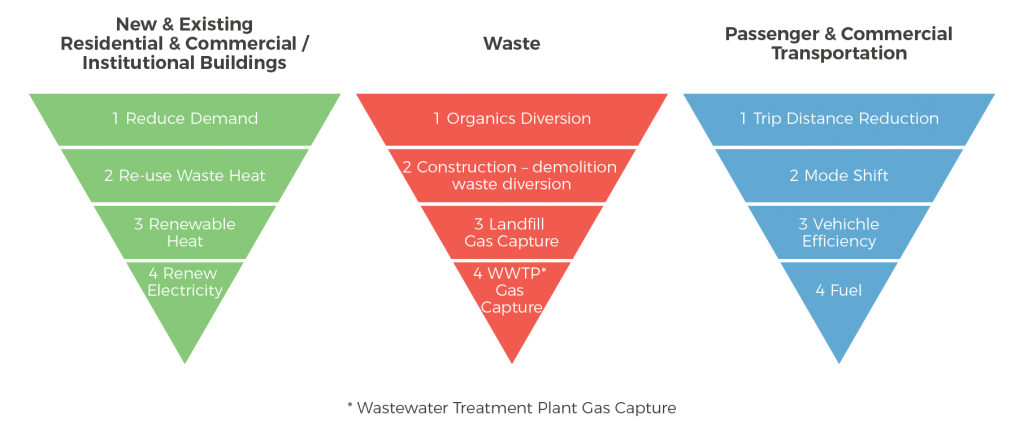
Consider CEP Renewal Early On
- It typically takes 5-7 years for a CEP to complete a development/implementation cycle
- Renewal should typically take place every 5-7 years to ensure that actions as well as the supporting rationale, data, analysis and impacts are up-to-date. Consider renewing the CEP when the majority of the actions in the CEP have been implemented or assessed for feasibility
- A community aiming to achieve an 80 percent reduction in energy and GHG emissions by 2050 will complete five to seven cycles between now and 2050
- Consider electoral, budgeting and other planning cycles when deciding on a frequency for CEP renewal
- Be explicit about when the CEP will be renewed
- Be adaptable. If circumstances change, consider renewing the CEP more or less frequently than was decided on initially
- If possible, avoid renewing the plan within 5 years of adoption. Renewal within a 5 year time frame can lead to “planning paralysis”, where it falls into the trap of expending its efforts on creating plans to the detriment of implementing them
Consider Developing a CEP at a Different Scale
- Consider developing a CEP at a regional scale. Participating local governments can then contribute a fair proportion of the cost to fund a dedicated staff person
- Consider housing the CEP within a local NGO, which may have access to more or different sources of funding to support a dedicated staff person
- Note that it is important to dedicate a staff person to oversee CEP development andimplementation
Relevant Resources
- National Report on Community Energy Plan Implementation
- National Report on Policies Supporting Community Energy Plan Implementation
- Community Energy Planning: The Value Proposition
- Policies to Accelerate Community Energy Plans: An analysis of British Columbia, Ontario and the Northwest Territories
- Natural Resources Canada RETScreen tool. RETScreen is free software and online training modules. The software includes support for project feasibility and performance analyses. This tool allows communities to conduct a preliminary financial assessment of community energy projects and can help to identify what changes, if any, would be needed to fund supporting staff, capital, operations and maintenance, programs and consultants, to mobilize implementation.
- IEA Energy Technology Network (2016). Cost and financing aspects of community renewable energy projects.
- Federation of Canadian Municipalities (2015). Alternative Financing Mechanisms compendium
Case Study 2: Measuring the Widespread Economic Benefits in the City of London, Ontario
The City of London, Ontario has conducted an economic analysis to measure various economic impacts and potential benefits of implementing their Community Energy Action Plan (CEAP). The analyses, conducted in-house, demonstrate community-wide energy spending, the proportion of energy spending leaving the local economy and the potential to recirculate energy spending based on the implementation of their plan.
The approach
- Energy spending analysis
Video supporting energy spending analysis: Turning energy data into energy dollars- The City of London has also produced infographics based on the analyses, available here
Case Study 3: Measuring Green Jobs in Durham Region, Ontario
The Region of Durham Community Climate Change Local Action Plan highlights the estimated environmental, economic and social impacts of implementation. The plan is available
Case Study 4: Measuring the Impacts of Sustainable Communities on Local Retail Sales New York City, New York
The New York City Department of Transportation created a methodology for measuring the economic impacts of improved streetscapes and active transportation infrastructure on retail sales. The study is available here: New York City Department of Transportation (December 2013). The Economic Benefits of Sustainable Streets. http://www.nyc.gov/html/dot/downloads/pdf/dot-economic-benefits-of-sustainable-streets.pdf
Case Study 5: Framing the Value Proposition, Edmonton, Alberta
The City of Edmonton, Alberta (population 812,000) adopted Edmonton’s Community Energy Transition Strategy in April 2015 and a corresponding City Policy C585 in August 2015.78 The Strategy, which represents a renewal and upgrade of their 2001 plan, was approved unanimously by City Council. Based on extensive citizen consultation, the strategy includes twelve strategic courses of action and an eight-year action plan with more than 150 tactics.
There is a lesson to be learned in how Edmonton’s Sustainable Development Department communicated the need for the strategy. First, it was framed as a risk management strategy designed to protect Edmonton’s quality-of life from climate and energy risks. Secondly, it provided a compelling economic business case involving ten community-scale programs (for advancing energy conservation, energy efficiency and renewable energy uptake) that would deliver a net public benefit of $3.3 billion over 20 years.
Case Study 13: Fort Providence, Northwest Territories
In 2007 and 2008 the community of Fort Providence, Northwest Territories (population 735), in partnership with the Arctic Energy Alliance, developed an energy profile.87
The objective of this exercise was to provide the community, and key decision makers, with a snapshot of energy use in the community.
The energy profile was developed to communicate a large quantity of energy data, including energy consumption, energy end use, cost of energy, and GHG emissions. Similar to any community that looks at energy use and costs per capita, the energy profile revealed significant opportunities to conserve energy and improve efficiency within the community.
Case Study 14: Halifax Vending Machine Energy Efficiency By-laws, Nova Scotia
In 2010, a series of by-laws and by-law amendments were adopted by Halifax City Council whereby a memorandum of Understanding was signed between the City and Refreshments Canada requiring the vending industry to voluntarily improve the energy efficiency of the vending machine fleet over 3 years. The estimated cost savings of the program were $500,000 per year and an annual reduction of 5,000 tons of GHG emissions. VendingMisers installed on the vending machines resulted in a 25-50 percent reduction in energy consumption per machine.88
Case Study 15: Net Zero Community in London, Ontario
West Five (www.west5.ca) is a 70 acre, mixed-use site located in London, Ontario. The site is being developed by Sifton Properties, in partnership with S2E Technologies. When completed, the neighbourhood will include 2,000 residential units, commercial and retail space, and parkland. The development will include a number of Smart Energy Community Principles,89 including energy efficient buildings (e.g. the use of enhanced insulation), the use of renewable energy resources (e.g. solar shingles) and matching land use needs and mobility options (e.g. siting services such as grocery stores at community terminals nodes). The site will include London’s first net-zero office building and net zero townhomes.
Read the Community Energy Knowledge Action Partnership case study here.
Case Study 16: Monitoring and Reporting on Implementation Progress in the City of Guelph, Ontario
CEP reporting is coordinated annually by the Community Energy division of the Business Development and Enterprise department, and presented to the Corporate Administration, Finance & Enterprise Committee (this Committee is appointed by Council and made up of Councillors). A dashboard is used to display progress within eight key activity categories, plus a description of the status for each individual activity.
See the Guelph Community Energy Plan here.
Case Study 17: Monitoring and Reporting on CEP Implementation in the City of London, Ontario
The City of London Community Energy Action Plan (CEAP) was adopted in 2014. Alongside the plan, the City of London developed a background document describing a methodology for monitoring and reporting on community energy use. The background document describes a methodology for developing annual energy and emissions inventories. The document describes how the City of London will also work with stakeholders to develop new Key Performance Indicators, including economic, transportation, and energy performance indicators. The results from energy and emissions inventories, and other Key Performance Indicators will be included in an annual progress report outlining implementation progress of the CEAP.90
Case Study 18: Efficiency One, Nova Scotia
Efficiency One in Nova Scotia, formerly Efficiency Nova Scotia, has provided on-site energy managers for organizations such as Cape Breton University, Capital District Health Authority, Dalhousie University and Nova Scotia Community College. These embedded energy managers help to identify and coordinate projects to achieve substantial energy efficiency savings. For example after first six months of the partnership between Efficiency One and Capital Health in 2012, several projects were initiated totalling savings of $118,000 per year.91
Case Study 19: Community Energy Planning Alternatives for Small Communities – Eco-Ouest
Eco-Ouest, led in partnership with CDEM, SSD, has developed a program designed to help provide expertise to smaller municipalities in Manitoba, Saskatchewan and Alberta that face resource and capacity constraints for CEP development and implementation. Eco-Ouest has partnered with rural municipalities in each of these provinces to create energy and GHG emissions inventories and Climate Change Local Action Plans such as the inventory for the Rural Municipality of St. Clements and plans for the Rural Municipality of Saint-Laurent and Rural Municipality of Taché. CDEM also incorporates a regional perspective by comparing neighbouring communities’ energy and emissions performances and sharing successful projects and case studies.92CDEM. (n.d.). Eco-West. Retrieved from CDEM Website: http://www.cdem.com/en/sectors/green-economy-1/eco-west
Case Study 22: Parking Incentives in Hamilton, Ontario
The City of Hamilton amended its Zoning By-law to support a transit-oriented multi-residential building, reducing parking space requirements from 1 space per unit in a multi-unit residential dwellings to 0.47 parking spaced per unit due to the building being located in a transit-oriented neighborhood.93
Strategy 10
Embed the CEP into Plans and Policies
Community energy planning is a unique process that unlike most local government initiatives, crosses over many departmental and organizational boundaries. CEPs, however, often fall short on being integrated into the existing plans and policies in local government because there typically lacks a process to integrate the CEP once it has been adopted by
Once a CEP is adopted, consider taking the important step of integrating the CEP into plans and policies immediately after CEP adoption.
GTI Advice
- Cast a wide net, and be strategic: Identify all opportunities to integrate the CEP into plans, policies and by-laws immediately after CEP adoption. Consider the timing for when some or all of the plans will be renewed and embed the CEP strategically
- Engage: Engage with all stakeholders, including staff and community stakeholders, that will be impacted by when and how the actions identified in a CEP are embedded into plans and policies. Obtain stakeholder input on how the plans and policies can be designed and/or amended to result in positive impacts
- Embed: Proceed with embedding the CEP actions into the plans and policies selected. Ensure that the clauses and policies are designed to maximize impacts and benefits of CEP implementation. Amend the identified plans, policies, by-laws and regulations as soon as possible after the opportunities have been identified to ensure that goals and actions included in the CEP remain top of mind for Council, staff and community stakeholders
- Be adaptable: The CEP is a living document and should be renewed and amended over time. Include clauses within policies and plans that allows changes to be made to the CEP without requiring additional amendments, for example, “the goals and actions of the Community Energy Plan, as amended from time to time”50
- Be explicit: Refer to the CEP goals and objectives within each plan, policy, by-law and regulation in a specific way, so that the direction set by the CEP and its impact on the plan is clear. Figure 7 describes light and deep approaches for embedding the CEP into plans and policies
- Follow up: Ensure that staff and community stakeholders are aware of new and amended policies. For example, if new development permit requirements are introduced, ensure that staff working in the development permit department are trained on the changes
Figure 7 – Approaches to Embedding the CEP into Plans and Policies

Often, the integration of energy into local plans and policies will have implications for community stakeholders. Ensure that community stakeholders are consulted during the design of new policies and programs to ensure that supports, requirements and incentives are designed to maximize their uptake.
The following examples describe how a CEP can be embedded into plans, policies, by-laws and regulations. The CEP can be incorporated into these plans as they are being developed, or they can be amended afterwards. All of the plans, policies, by-laws and regulations listed below should be considered in your community. Consider how lightly or deeply the CEP should be embedded into each plan and policy.
Embed the CEP into Plans - Council Strategic Plans
A Strategic Plan is a council-led plan that identifies priorities, typically over a four year period. It can also include a 20-40 year vision.
Strategic Plans can be used to embed or apply an energy lens on decision-making. Making the environment or energy security a priority at the community level allows Council to make strategic investments in studies and plans like community energy plans, environmental master plans, or targeted plans and policies related to energy. It also allows funds to be allocated to these types of studies.
Council Strategic Plan in City of Coquitlam, British Columbia: The City of Coquitlam, British Columbia’s strategic plan, contains actions related to implementing the Community Greenhouse Gas Reduction Strategy including:
- Creating an energy efficient community
- Implementing district energy where feasible
- Developing policies to encourage higher performance buildings, passive design, and renewable energy51
Council Strategic Plan in Burlington, Ontario: The Burlington strategic plan, Burlington, Our Future, includes actions to improve energy management within the community as a way to achieve economic prosperity. Actions within the Strategic Plan include:
- Promoting and encouraging lower community energy consumption
- Expanding renewable energy initiatives
- Developing a Community Energy Plan52
The City of Burlington successfully developed and adopted a CEP in 2014.53
Embed the CEP into Plans - Official Plans and Regulations
Official Plans outline growth objectives and guide the land use planning of a community. Depending on the Province or Territory and the community, can be called an Official Plan, Official Community Plan, Development Plan, Master Plan, Municipal Plan, or Comprehensive Plan. For many communities the Official Plan guides all land use making decisions. CEP actions related to integrating land use and transportation, enhancing energy efficiency, and accelerating the implementation of distributed energy resources, can be included in an Official Plan.
The Regional Municipality of York, Ontario: The Regional Municipality of York Official Plan,
The Resort Municipality of Whistler, British Columbia: The Resort Municipality of Whistler notes in its Official Community Plan that “As a signatory to the BC Climate Action Charter the Council of the Resort Municipality of Whistler has expressed its understanding that anthropogenic emissions of greenhouse gases are affecting the global climate; that reducing these emissions is therefore beneficial and important to all citizens; and that governments must act promptly to mitigate climate change. The Municipality considers it appropriate to adopt targets, policies and actions intended to reduce the emission of greenhouse gases within Whistler and resulting from activities related to the ongoing operation of the resort community. The targets are stated below, along with related policies and actions. Other relevant policies and actions are found throughout the OCP, because the Municipality recognizes that reducing greenhouse gas emissions can be achieved by all sectors of the resort community, and in all aspects of its operation.”55
Embed the CEP into Plans - Secondary Plans (Official Plan Amendments)
Through the Secondary Plan process, communities can create the conditions for CEP implementation by encouraging or requiring increased population and/or employment densities, land use mixes, transit-oriented development, distributed energy resources, etc.
Secondary Plan in the City of Toronto, Ontario: In 2014, the City of Toronto adopted the Scarborough Centre Secondary Plan which encourages developers to accommodate renewable energy generation and distribution systems, as well as charging infrastructure for electric vehicles. The policies are as follows:
1.4.9 Community Energy
- New development and the re-development of existing buildings within the McCowan Precinct will contribute to achieving the City’s target for reducing energy use and reducing greenhouse gas emissions. Proponents of new development and redevelopment of existing buildings will be guided by the Community Energy Plan prepared as part of the McCowan Precinct Plan Study (2014) and will work with the City to assess opportunities to contribute to the City’s energy targets through sustainable development.
- Development is encouraged to promote and accommodate renewable energy generation and distribution systems to assist in reducing greenhouse emissions,
off- setting on site energy consumption, and securing a sustainable and stable energy distribution and supply. Energy technologies such as geothermal, combined heat and power co-generation, solar thermal heating, solar cooling, heat recovery, short- and long-term energy storage, and solarphoto-voltaic will be encouraged. Building design and site planning to achieve passive solar heating in cold weather months will also be encouraged. - Development will be encouraged to incorporate facilities to re-charge electric-powered vehicles either as a private or common amenity for building occupants or on
pay-per-use basis for the general public.56
Embed the CEP into Plans - Other Plans
Other plans include Transportation Plans, Urban Forest Management Plans, Housing Plans, Solid Waste Plans, Economic Development Plans, Sustainability Plans and others.
Most CEPs will contain actions that relate to transportation, urban forest management, housing and solid waste, among others. Staff developing these plans should become aware of the actions in the CEP and how they impact their work plans.
Communications Plans
The communications department is responsible can incorporate the CEP into both internal and external communications.
Internal Communications
- Update staff on CEP implementation often through internal communications channels
- Encourage staff to share anecdotes on CEP implementation with the communications department so that they may be disseminated frequently
External Communications
- Engage with the public when deemed appropriate (e.g. for program implementation and significant CEP updates). See Strategy 7: Engage Community Stakeholders and Recognize their Implementation Progress
- Some local governments administer household/business surveys. Consider including questions within the survey that may provide data for Key Performance Indicators. See Strategy 8: Monitor and Report on CEP Implementation
Embed the CEP into Plans - Community Improvement Plans
Community Improvement Plans
Community Improvement Plans (CIPs) allow cities/communities to create the conditions to increase densities and/or encourage brownfield redevelopment for a designated area within a municipality. CIPs can help trigger development supportive of active transportation, use of public transportation and can even help concentrate development, and consequently energy end use, in a way that improves the business case for distributed energy resources.
CIPs in Moncton, New Brunswick: In 2015, The City of Moncton introduced a financial incentive program to revitalize vacant and under-utilized properties within the Downtown Community Improvement Plan area. The program aims to enhance mixed-use, sustainable and transit-oriented development in the downtown core.65
CIPs in Calgary, Alberta: In 2002, The Apex Corporation completed The Renaissance at North Hill, in Calgary. The project illustrates that redevelopment of large shopping centre parking lots to provide residential units can reap benefits for both the mall owners and developers. The developer considers good communications with surrounding neighbours, as well as building good relationships with the City, to be key factors.66
Embed the CEP into Policies - Zoning By-laws
Zoning by-laws state how land will be used in a community and outlines specific requirements for building use, density, height, size, and location. Zoning by-laws and amendments can be used to encourage or require intensification targets, the integration of land use and transportation, the acceleration of alternative modes of transportation, distributed energy resources, and energy efficiency requirements.
Energy efficiency in the City of Halifax, Nova Scotia: In 2010, a series of by-laws and by-law amendments were adopted by Halifax City Council whereby a Memorandum of Understanding was signed between the City and Refreshments Canada requiring the vending industry to voluntarily improve the energy efficiency of the vending machine fleet over 3 years. The estimated cost savings of the program were $500,000 per year and an annual reduction of 5,000 tons of GHG emissions. VendingMisers installed on the vending machines resulted in a 25-50 percent reduction in energy consumption per machine.57
Distributed energy resources in the City of Vancouver, British Columbia: In 2013, the City of Vancouver adopted a by-law requiring owners of new buildings proposed for construction and existing buildings undergoing significant alterations in the Southeast False Creek neighborhood to connect to the local district energy system.58
Distributed energy resources in the City of Calgary, Alberta: The City of Calgary adopted revisions to the Centre City By-law providing incentives for green building features including district energy connections, co-generation facilities and electric vehicle charging stations, among others.59
Increasing density and compact, mixed-use communities in the City of Calgary, Alberta: The City of Calgary adopted a zoning by-law amendment rezoning a mall parking lot to allow for a high-density residential development in a mixed use area. The development provided residents with greater access to essential services and amenities and reduced their dependency on private vehicles.60
Increasing density and compact, mixed-use communities in Koo’s Corner, British Columbia: In 2002, Koo’s Corner, located in the Strathcona neighbourhood in Vancouver, British Columbia was completed. The project represents a best practices as it relates to infill development. The City of Vancouver allowed a higher density for the project than what was permitted in the Vancouver Charter, enabling the project to be viable.61
Increasing density and compact, mixed-use communities in the City of Richmond, British Columbia: The City of Richmond identified as a priority in its 2014 Community Energy and Emissions Plan to review subdivision by-laws to encourage transit-oriented design to support investments in active transportation infrastructure.62
Parking incentives in the City of Hamilton, Ontario: The City of Hamilton amended its Zoning By-law to support a transit-oriented multi-residential building, reducing parking space requirements from 1 space per unit in a multi-unit residential dwellings to 0.47 parking spaced per unit due to the building being located in a transit-oriented neighborhood.63
Embed the CEP into Policies - Site Plan Control
Site plan control is a tool that local governments can use to ensure that certain requirements are met before a site is developed. By including design considerations in site plans, communities can promote energy and GHG reduction activities, including energy efficiency requirements such as those used in outdoor lighting.
Site plan control in Toronto, Ontario: The Toronto Green Standard (TGS) uses site plan approvals to require new private and public development to meet green building requirements. As of January 31, 2010, the City of Toronto uses this two-tiered set of performance measures for new development, organized by three building types. It requires planning applications, including zoning by-law amendments, site plan approval and draft plan of subdivision to meet Tier 1 requirements. Tier 1 requirements are mandatory and Tier 2, a higher level of performance, is voluntary. These performance measures were instituted to address a number of issues, consistent with the Official Plan’s broad policies, including air and water quality, greenhouse gas emissions, energy efficiency, solid waste and the natural environment.71
Embed the CEP into Policies - Height and Density Bonusing
Height and density bonusing
Height and density bonusing in the City of Port Coquitlam, British Columbia: In 2008, the City of Port Coquitlam adopted a regulation allowing developers to be eligible for density bonusing if proposed developments achieve LEED Silver Certification equivalency in designated areas within the municipality. Funds collected are deposited into the City’s facilities amenity fund and the social housing amenity fund and are allocated to meet council’s strategic goals.64
Embed the CEP into Policies - Plan of Subdivision
A plan of subdivision is used when dividing
Plans of subdivision in the City of Toronto, Ontario: The City of Toronto requires large development proposals within a Community Energy Plan area to submit an Energy Strategy. This requirement applies to Plans of Subdivision and Official Plan and Zoning By-law amendments.68
Plans of subdivision in the City of Richmond, British Columbia: The City of Richmond identified as a priority in its 2014 Community Energy and Emissions Plan to review subdivision by-laws to encourage transit-oriented design to support investments in active transportation infrastructure.69
Embed the CEP into Policies - Development Permits
Development permit areas/systems combine site plan control, zoning, and minor variance together in one application format, providing an expedited and simplified application process. Development permit systems can include requirements for brownfield redevelopment, green roof installation, water conservation measures, street and lot layout that reduces energy consumption, transportation demand management, installation of distributed energy resources, and to encourage energy efficiency and GHG reductions.
Development permit areas in Calgary, Alberta: In 2015, the City of Calgary introduced a Development Permit Exemption program to simplify the implementation of secondary suites in specified land use districts within Calgary. The program waives the application fees for secondary suites and in some cases eliminates the requirement to submit a development permit. A secondary suite is a separate living unit created within a single-family home. A by-law allowing secondary suites encourages neighbourhood intensification.70
Embed the CEP into Policies - Development Cost Charges
Development cost charges in the City of Penticton, British Columbia: The City of Penticton reduces Development Cost Charges for low energy impact developments by 50 percent.72
Development cost charges in the Niagara Region, Ontario: The Niagara Region Development Charges Reduction Program offers development charge exemptions ranging from 50-75 percent for developments located within central areas, or on brownfield sites within central areas and for LEED projects.73
Embed the CEP into Policies - Parking Charges
Parking charges can provide a variety of benefits, including traffic reduction, increased turnover of spaces, reduced cruising for parking, and new revenue for the municipality. Parking charges are often used in tandem with an overall reduction in parking spaces, which leads to more compact development and promotes alternative forms of transportation. In turn, energy consumption and emissions are reduced.
Parking Charges in the Town of Banff, Alberta: In 2014 the Town of Banff, Alberta introduced a parking charge pilot program converting free parking in the downtown core to paid parking in an effort to encourage the uptake of alternative modes of transportation among residents and tourists.74
Appendices
Appendix I - Framework Methodology
The Community Energy Implementation Framework has been developed as part of the Community Energy Planning: Getting to Implementation in Canada initiative. It has been informed by:
- An in-depth review of 50 CEPs across Canada
- Interviews with 33 representatives from the communities of the 50 CEPs reviewed
- Input from over 800 stakeholders through workshops and focus groups in British Columbia, Alberta, Saskatchewan, Manitoba, Ontario, Québec, New Brunswick, Nova Scotia, Prince Edward Island, Yukon, Northwest Territories and Nunavut79
- Desk-top research on community energy planning including topics such as the value proposition as well as the role of provincial, territorial and federal government
- Testing the Framework Strategies in three GTI Pilot Communities: Campbell River, British Columbia, Calgary, Alberta and the Region of Waterloo, Ontario
- Input from the GTI Advisory Committee and other expert advisors
Appendix II - Resources to Get Started with your CEP
The following resources are available to help communities get started with their CEP.
- Community Energy and Emissions Plan Guide (Community Energy Association)
- Community Energy Planning Primer for New Brunswick Municipalities (QUEST)
- Advancing Integrated Community Energy Planning in Ontario: A Primer (QUEST)
- How to Create a Local Action Plan (Federation of Canadian Municipalities)
- Passing Go: Moving Beyond the Plan (Federation of Canadian Municipalities)
- Community Energy Planning Guide (Natural Resources Canada)
- Community Energy Planning in Yukon: Determining Priorities of Local Governments (Yukon Energy Solutions Centre)
- Illustrated Guide to Community Energy (Collaborative for Advanced Landscape Planning)
- Cleantech Community Gateway
Appendix III - Case Study Reference Guide
The following case studies offer best practices for operationalizing the strategies identified in the Community Energy Implementation Framework. Click here for a printable PDF version of the Case Study Reference Guide.
Case Study 1: CEP Renewal in the City of Yellowknife, Northwest Territories
The City of Yellowknife adopted a CEP in 2006. With a target year of 2014, Yellowknife aimed to reduce its corporate GHG emissions by 20 per cent and its community GHG emissions 6 per cent, based on 2004 levels. It budgeted $500,000 annually for energy efficiency, renewable energy conversions and public awareness. By February 2013, the City surpassed its target and the projects implemented now save the City an estimated $528,000 per year.76 One of the last steps initiated during the implementation of the CEP was the adoption of a renewal process for the plan. This renewal process included the development of a strategy for public and community stakeholder engagement to support the creation of a CEP for 2015-2025. Yellowknife has since embarked on a process where a new assessment of the Community’s GHG emissions will be completed and new targets will be established.
Case Study 2: Measuring the Widespread Economic Benefits in the City of London, Ontario
The City of London, Ontario has conducted an economic analysis to measure various economic impacts and potential benefits of implementing their Community Energy Action Plan (CEAP). The analyses, conducted in-house, demonstrate community-wide energy spending, the proportion of energy spending leaving the local economy and the potential to recirculate energy spending based on the implementation of their plan. The approach undertaken and resources are available here:
- Energy spending analysis
- Video supporting energy spending analysis: Turning energy data into energy dollars https://vimeo.com/120112918
The City of London has also produced infographics based on the analyses, available here: https://www.london.ca/residents/Environment/environmental-initiatives/Pages/Infographics.aspx
Case Study 3: Measuring Green Jobs in Durham Region, Ontario
The Region of Durham Community Climate Change Local Action Plan highlights the estimated environmental, economic and social impacts of implementation. The plan is available at: Durham Region (2012). From Vision to Action Region of Durham Community Climate Change Local Action Plan. https://www.durham.ca/community/climate_change/2012DurhamLAP.pdf
Case Study 4: Measuring the Impacts of Sustainable Communities on Local Retail Sales New York City, New York
The New York City Department of Transportation created a methodology for measuring the economic impacts of improved streetscapes and active transportation infrastructure on retail sales. The study is available here: New York City Department of Transportation (December 2013). The Economic Benefits of Sustainable Streets. http://www.nyc.gov/html/dot/downloads/pdf/dot-economic-benefits-of-sustainable-streets.pdf
Case Study 5: Framing the Value Proposition, Edmonton, Alberta
The City of Edmonton, Alberta (population 812,000) adopted Edmonton’s Community Energy Transition Strategy in April 2015 and a corresponding City Policy C585 in August 2015.78 The Strategy, which represents a renewal and upgrade of their 2001 plan, was approved unanimously by City Council. Based on extensive citizen consultation, the strategy includes twelve strategic courses of action and an eight-year action plan with more than 150 tactics.
There is a lesson to be learned in how Edmonton’s Sustainable Development Department communicated the need for the strategy. First, it was framed as a risk management strategy designed to protect Edmonton’s quality-of life from climate and energy risks. Secondly, it provided a compelling economic business case involving ten community-scale programs (for advancing energy conservation, energy efficiency and renewable energy uptake) that would deliver a net public benefit of $3.3 billion over 20 years.
Case Study 6: Establishing a Committee of Council in Yellowknife, Northwest Territories
The Community Energy Planning Committee was established by City Council on September 10, 2007, following the completion of the Community Energy Plan (CEP).79 The Committee is chaired by the Mayor and includes representatives from across the Community. The primary purpose of the Committee is to assist the City of Yellowknife in an advisory capacity to ensure the CEP is implemented and evolves in an effective manner. The scope of the Committee is to report and make recommendations to City Council through the appropriate standing Committee of Council on the progress and direction of the CEP implementation.80
Case Study 7: Establishing a Governance Framework for Edmonton’s Community Energy Transition Strategy, Edmonton, Alberta
Edmonton City Council formed an Energy Transition Advisory Committee.81 Committee members serve two year terms and sets out to encourage and promote the strategy, provide advice to Council regarding the implementation of the strategy and assist Council in developing performance measures.
Case Study 8: Stakeholder Engagement in the City of Kelowna, British Columbia
In 2012, the City of Kelowna adopted a Community Climate Action Plan containing 87 actions to be implemented by 2020. Of those actions, 59 were assigned to the local government and 28 were assigned to community stakeholders, including utilities, provincial government and others. In an effort to ensure that community stakeholders understood their roles in the implementation of the plan, the City of Kelowna circulated letters to the organizations responsible for implementing actions in the plan. These letters enabled the City of Kelowna to move forward on implementing actions that are not within its jurisdiction.82
Case Study 9: Stakeholder Engagement in Markham, Ontario
In 2014, the City of Markham began to develop a Municipal Energy Plan (MEP). As part of the MEP, the City created a Stakeholder Working Group.83
The desired outcome of the Stakeholder Working Group is to provide recommendations and feedback on the development of Markham’s MEP including:
- Identifying energy opportunities and solutions to increase local energy production and conservation
- Identifying synergies between industry stakeholders to implement MEP recommendations84
Case Study 11: Public Engagement on Community Energy in London, Ontario
The City of London, Ontario has documented public engagement efforts in a document entitled Learning from People: A Background Document for the Community Energy Action Plan: https://www.london.ca/residents/Environment/Energy/Documents/Learning_from_People.pdf
As part of the development of the Community Energy Action Plan, the City of London undertook a campaign called ReThink Energy London. The City of London held a Community Energy Strategy Workshop and the London Roundtable on the Environment and the Economy to inform the development of the Community Energy Action Plan. Community Energy Strategy Workshop included an interactive energy mapping exercise that involved 31 participants from electrical, natural gas and thermal utilities, internal departments, environmental and transportation advisory committees and provincial staff, among other stakeholders. The city’s energy map was used to help stakeholders identify energy opportunities and risks, and to generated ideas and principles for energy actions in key areas such as buildings, transportation and low carbon energy generation in the City of London. Outcomes from the workshop can be found here: https://www.london.ca/residents/Environment/Climate-Change/Documents/London_FINALSummaryofWorkshop_May11.pdf
Case Study 12: City of Yellowknife Community Energy Plan Communications Plan, Northwest Territories
The City of Yellowknife Community Energy Plan Communications Plan describes a detailed approach for engaging with the public.86 At the core of the plan, there is a recognition that in order to reduce GHG emissions across the community, Yellowknife residents and businesses must change current energy use practices. This requires a shift in awareness, attitudes and behaviour with respect to GHG emissions. The overall communication goal of the plan is to inform Yellowknife residents of changes that the City of Yellowknife will make and to implement communication programs that encourage ongoing reductions in Yellowknife GHG emissions.
Case Study 13: Fort Providence, Northwest Territories
In 2007 and 2008 the community of Fort Providence, Northwest Territories (population 735), in partnership with the Arctic Energy Alliance, developed an energy profile.87
The objective of this exercise was to provide the community, and key decision makers, with a snapshot of energy use in the community.
The energy profile was developed to communicate a large quantity of energy data, including energy consumption, energy end use, cost of energy, and GHG emissions. Similar to any community that looks at energy use and costs per capita, the energy profile revealed significant opportunities to conserve energy and improve efficiency within the community.
Case Study 14: Halifax Vending Machine Energy Efficiency By-laws, Nova Scotia
In 2010, a series of by-laws and by-law amendments were adopted by Halifax City Council whereby a memorandum of Understanding was signed between the City and Refreshments Canada requiring the vending industry to voluntarily improve the energy efficiency of the vending machine fleet over 3 years. The estimated cost savings of the program were $500,000 per year and an annual reduction of 5,000 tons of GHG emissions. VendingMisers installed on the vending machines resulted in a 25-50 percent reduction in energy consumption per machine.88
Case Study 15: Net Zero Community in London, Ontario
West Five (www.west5.ca) is a 70 acre, mixed-use site located in London, Ontario. The site is being developed by Sifton Properties, in partnership with S2E Technologies. When completed, the neighbourhood will include 2,000 residential units, commercial and retail space, and parkland. The development will include a number of Smart Energy Community Principles,89 including energy efficient buildings (e.g. the use of enhanced insulation), the use of renewable energy resources (e.g. solar shingles) and matching land use needs and mobility options (e.g. siting services such as grocery stores at community terminals nodes). The site will include London’s first net-zero office building and net zero townhomes.
Case Study 16: Monitoring and Reporting on Implementation Progress in the City of Guelph, Ontario
CEP reporting is coordinated annually by the Community Energy division of the Business Development and Enterprise department, and presented to the Corporate Administration, Finance & Enterprise Committee (this Committee is appointed by Council and made up of Councillors). A dashboard is used to display progress within eight key activity categories, plus a description of the status for each individual activity.
Case Study 17: Monitoring and Reporting on CEP Implementation in the City of London, Ontario
The City of London Community Energy Action Plan (CEAP) was adopted in 2014. Alongside the plan, the City of London developed a background document describing a methodology for monitoring and reporting on community energy use. The background document describes a methodology for developing annual energy and emissions inventories. The document describes how the City of London will also work with stakeholders to develop new Key Performance Indicators, including economic, transportation, and energy performance indicators. The results from energy and emissions inventories, and other Key Performance Indicators will be included in an annual progress report outlining implementation progress of the CEAP.90
Case Study 18: Efficiency One, Nova Scotia
Efficiency One in Nova Scotia, formerly Efficiency Nova Scotia, has provided on-site energy managers for organizations such as Cape Breton University, Capital District Health Authority, Dalhousie University and Nova Scotia Community College. These embedded energy managers help to identify and coordinate projects to achieve substantial energy efficiency savings. For example after first six months of the partnership between Efficiency One and Capital Health in 2012, several projects were initiated totalling savings of $118,000 per year.91
Case Study 19: Community Energy Planning Alternatives for Small Communities – Eco-Ouest
Eco-Ouest, led in partnership with CDEM, SSD, has developed a program designed to help provide expertise to smaller municipalities in Manitoba, Saskatchewan and Alberta that face resource and capacity constraints for CEP development and implementation. Eco-Ouest has partnered with rural municipalities in each of these provinces to create energy and GHG emissions inventories and Climate Change Local Action Plans such as the inventory for the Rural Municipality of St. Clements and plans for the Rural Municipality of Saint-Laurent and Rural Municipality of Taché. CDEM also incorporates a regional perspective by comparing neighbouring communities’ energy and emissions performances and sharing successful projects and case studies.92CDEM. (n.d.). Eco-West. Retrieved from CDEM Website: http://www.cdem.com/en/sectors/green-economy-1/eco-west
Case Study 20: Yukon Energy Solutions Centre
The Yukon Energy Solutions Centre is part of the Energy branch in the Government of Yukon Department of Energy, Mines and Resources.
The Energy Solutions Centre offers community-level energy services to such as:
- Providing technical information and financial incentives to encourage the use of energy efficient appliances and heating systems at the local level
- Providing comprehensive energy planning services, including energy baseline assessments and policy reviews
- Providing training courses to build local technical capacity to implement community energy plans and projects
- Participating in outreach and public education on the health, safety, economic and environmental benefits of energy efficiency and renewable energy
To learn more about the Energy Solutions Centre visit http://www.energy.gov.yk.ca/about-the-energy-branch.html
Case Study 21: Integrated Financial Planning in the City of Coquitlam, British Columbia
Coquitlam’s award-winning integrated financial planning framework is comprised of three separate but complementary planning processes. These processes result in a set of integrated plans that support the overall vision and mission of the City and align activities and resources to achieve the strategic goals and annual business plan priorities set by Council.
- Council’s Strategic Plan – aspirational, future-looking plan, updated every four years following the municipal election. It articulates the vision, mission, values and broad strategic goals. Progress of the plan is monitored through an annual review of key performance measures and accomplishments
- Business Plan – translates the high level strategic goals into annual business plan work items and priorities, established by Council. A set of performance measures are reviewed annually to monitor success of the business plan
- Financial Plan – provides the resourcing strategy to support the strategic and business plans. Updated annually, it is a five-year plan that includes both operating and capital components
Evaluation of achievements informs the next cycle of planning. For example, the City’s performance is reviewed every four months with a Trimester Report to Council. It includes an update on the progress of the work items under the Business Plan priorities and a review of operating and capital budget variances, labour vacancies, economic indicators including construction and development activities, and major spending during the trimester. The intent of the report is to view the City’s activities and progress balanced with the status of the City’s financial and human resources.
In this model, it is important that staff responsible for developing and implementing the CEP ensure that its goals and actions are reflected in Council’s (strategic) plan and that these goals and actions maintain a high profile throughout the budgeting/financial plan process.
See the Strategic Plan here: City of Coquitlam (2012). 2012-2015 Strategic Plan. http://www.coquitlam.ca/docs/
Case Study 22: Parking Incentives in Hamilton, Ontario
The City of Hamilton amended its Zoning By-law to support a transit-oriented multi-residential building, reducing parking space requirements from 1 space per unit in a multi-unit residential dwellings to 0.47 parking spaced per unit due to the building being located in a transit-oriented neighborhood.93
Appendix IV - Provincial and Territorial Organizations that May Have Resources to Support CEPs
One of the greatest success factors to CEP implementation is engaging with other communities and with organizations that have the tools needed to accelerate implementation. The following organizations and communities of practice may have information available to help find the tools needed to implement particular aspects of your CEP.
British Columbia
- Community Energy Association (CEA) – communityenergy.bc.ca
- QUEST BC Caucus – https://questcanada.org/caucus/bc
- BC Mayor’s Climate Leadership Council – http://communityenergy.bc.ca/bcmclc/
- Union of BC Municipalities (UBCM) – http://www.ubcm.ca/
- Planning Institute of British Columbia (PIBC) – https://www.pibc.bc.ca/
- BC Climate Action Toolkit – http://www.toolkit.bc.ca/
Alberta
- QUEST Alberta Caucus -https://questcanada.org/caucus/ab
- Alberta Energy Efficiency Alliance (AEEA) – http://www.aeea.ca/
- Alberta Professional Planners Institute (APPI) – http://www.albertaplanners.com/
- Alberta Council for Environmental Education (ACEE) – http://www.abcee.org/
- Alberta Urban Municipalities Association (AUMA) – http://www.auma.ca/
- Alberta Association of Municipal Districts and Counties (AAMDC) – http://www.aamdc.com/
- Alberta Innovates – http://www.ai-ees.ca/
- Municipal Climate Change Action Centre (MCCAC) – www.mccac.ca
Saskatchewan
- Eco-Ouest – http://www.cdem.com/en/sectors/greeneconomy-1/eco-west
- Conseil de la Coopération de la Saskatchewan (CCS) – http://ccs-sk.ca/
- Saskatchewan Research Council (SRC) – http://www.src.sk.ca/industries/energy/pages/default.aspx
- Saskatchewan Professional Planners Institute (SPPI) – http://sppi.ca/
- Saskatchewan Urban Municipalities Association (SUMA) – http://www.suma.org/
- Saskatchewan Economic Development Association (SEDA) – http://www.seda.sk.ca/index.cfm
- First Nations Power Authority of Saskatchewan (FNPA) – http://www.fnpa.ca/
Manitoba
- Conseil de développement économique des municipalities billingues du Manitoba (CDEM) Eco-West – http://www.cdem.com/en/sectors/greeneconomy-1/eco-west
- Manitoba Professional Planners Institute – http://www.mppi.mb.ca/
Ontario
- QUEST Ontario Caucus – www.questcanada.org/caucus/on
- Ontario Professional Planners Institute – http://ontarioplanners.ca/
- Association of Municipalities of Ontario – www.amo.on.ca/
- Clean Air Partnership – http://www.cleanairpartnership.org/
Québec
- Agence de l’efficacité énergétique – http://www.efficaciteenergetique.gouv.qc.ca/
- Association Québécoise pour la maîtrise de l’energie (AQME) – http://www.aqme.org/
- Climatisation et chauffage urbains de Montréal (CCUM) – ccum.com
- Conseil Patronal de l’Environnement du Québec (CPEQ) – http://www.cpeq.org/fr
- Fédération Québécoise des Municipalités – http://fqm.ca/
- L’Ordre des Urbanistes du Québec – http://www.ouq.qc.ca/
- QUEST Caucus du Québec – https://questcanada.org/fr/caucus/qc
- Regroupement national des conseils régionaux de l’environnement (RNCREQ) – http://www.rncreq.org/
- Hydro Québec – http://www.hydroquebec.com/promoteurs/developpementurbaindurable/
Atlantic Provinces
- QUEST Nova Scotia Caucus – https://questcanada.org/caucus/ns
- Union of Nova Scotia Municipalities (UNSM) – http://www.unsm.ca/sustainabilityoffice.html
- QUEST New Brunswick Caucus – https://questcanada.org/caucus/nb
- Association of Municipal Administrators of New Brunswick – http://www.amanb-aamnb.ca/
- Atlantic Planning Institute – http://www.atlanticplanners.org/
- Clean Foundation – clean.ns.ca
- Ecology Action Centre – https://www.ecologyaction.ca
- EOS Eco-Energy – eosecoenergy.com
Territories
- QUEST North Caucus – https://questcanada.org/caucus/north
- Yukon Energy Branch – http://www.energy.gov.yk.ca/publications.html
- Association of Yukon Communities – http://www.ayc-yk.ca/
- Council of Yukon First Nations – http://cyfn.ca/
- Yukon Conservation Society – http://www.yukonconservation.org/energy_climate_change.htm
- Yukon Research Centre – http://yukoncollege.yk.ca/research
- Arctic Energy Alliance – aea.nt.ca
- NWT Association of Communities (NWTAC) – http://www.nwtac.com/
- Nunavut Association of Municipalities (NAM) – http://www.nmto.ca/governance/nunavutassociation-municipalities
National
- Natural Resources Canada – https://www.nrcan.gc.ca/energy/efficiency/communities-infrastructure
- Canadian Energy Research Institute (CERI) – http://www.ceri.ca/
- Federation of Canadian Municipalities (FCM) – www.fcm.ca/home.htm
- The Natural Step – http://www.naturalstep.ca/
- Sustainable Development Technology Canada (SDTC) – https://www.sdtc.ca/en
- Sustainable Cities – http://sustainablecities.net/
Copyright © QUEST – Quality Urban Energy Systems of Tomorrow, 2016. These materials may be reproduced in whole or in part without charge or written permission, provided that appropriate source acknowledgements are made and that no changes are made to the contents. All other rights are reserved. The analyses/views in these materials are those of
Implementation Readiness Survey
To get the most out of the Framework, communities are encouraged to complete the Community Energy Implementation Readiness Survey.
The Community Energy Implementation Readiness Survey is a self-evaluation tool that allows you to assess the extent to which your community has the factors in place to implement a Community Energy Plan. Factors are related to:
- The Community Energy Plan
- Community context
- Management and governance
- Staff and financial resources
- Stakeholder engagement
It takes 5-10 minutes to complete and by completing the survey, you will get access to recommended strategies to consider for the implementation of your Community Energy Plan.
Publications
Resources
The Community Energy Implementation Framework
Click here to access the interactive web-based Community Energy Implementation Framework and Readiness Survey.
Click here to download a PDF version of the Community Energy Implementation Framework and Readiness Survey.
The Smart Energy Atlas
Community Energy Planning: The Value Proposition
- Help achieve environmental and community health goals
- Recirculate money spent on energy within a community and its region
- Contribute to achieving local economic development goals
- Create opportunities for local energy cost savings and job creation
- help to mitigate financial risks from future carbon pricing and energy price volatility
- Contribute to strong and resilient local economies
- And achieve other broad economic impacts
Download the Executive Summary here (PDF).
Download the full report here (PDF).
View the webinar here.
Download the webinar presentations here:
National Report on Community Energy Plan Implementation
- Defines what a Community Energy Plan is, what the key drivers are, and what benefits a CEP has for a community
- Provides a snapshot of CEP implementation in Canada and introduces a CEP implementation scoring system
- Describes success factors and barriers for CEP implementation based on the analysis of 50 Plans across Canada
- Provides key considerations going forward for the development of a Community Energy Implementation Framework
Download the full report here (PDF).
Download the CEP evaluation characteristics and criteria used for this research here (.xls)
Status Report on Community Energy Plan Implementation: A Follow up to the National Report on Community Energy Plan Implementation
Download the full report here (PDF).
Methods for Measuring the Economics of Community Energy Plans
Download the full report here (PDF).
National Report on Policies Supporting CEP Implementation
- A review of the role that communities play in supporting energy objectives at the provincial and territorial level;
- A review of provincial and territorial policy approaches that support CEP development and CEP implementation in Canadian
communities; - Examples of how CEP implementation is helping provinces and territories achieve their energy objectives, and
- An overview of how the effective approaches identified can be replicated by other provinces and territories.
Download the full report here (PDF).
Download the Executive Summary here (PDF).
Download the French Executive Summary here (PDF).
Download Appendix I – Provincial and Territorial Policies Supporting CEP Implementation here (.xls).
Policies to Accelerate Community Energy Plans: An Analysis of British Columbia, Ontario and the Northwest Territories
Download the Executive Summary here (PDF).
Download the Full Report here (PDF).
Download the Policy Database here (PDF).
A Funding Guide for Alberta Communities
Download the Guide here (PDF).
Project Update
- Update #1 outlines how provincial and territorial governments across Canada are supporting community energy planning.
- Update #2 describes local factors supporting or impeding CEP implementation, and provides a preliminary list of recommendations that will help achieve successful implementation of CEPs.
- Update #3 highlights ways that you can get involved in the Getting to Implementation project.
Download the project update here (PDF).
Workshop
Resources
The Community Energy Planning: Getting to Implementation in Canada project team has hosted 10 workshops and webinars across Canada and has received input from more than 300 thought leaders on their perspective on the challenges, opportunities and best practices associated with CEP implementation in Canadian communities. Find the workshop resources and presentations here.
Workshop: Getting to Implementation in Canada
Workshop: Getting to Implementation in British Columbia
Workshop: Getting to Implementation in Alberta
Workshop: Getting to Implementation in Saskatchewan
Workshop: Getting to Implementation in Nova Scotia
Workshop: Getting to Implementation in New Brunswick
Atelier-conférence: La planification énergétique communautaire au Québec
Workshop: Getting to Implementation in the North
Workshop Summary Report
Infographics
Resources
External
Resources
The following tools and resources have been developed to help Canadian communities advance Community Energy Plans.
Frequently Asked Questions
1: What is a Community Energy Plan?
- Energy efficiency in new and existing buildings
- Transportation and public transit
- Active transportation
- Low carbon vehicles and other transportation actions, including policies on anti-idling
- Waste, including landfill gas
- Renewable energy, district energy and combined heat and power
- Water consumption
- Planning and policy measures
- Stakeholder outreach
2: What are the benefits of developing and implementing a Community Energy Plan?
Implementing a Community Energy Plan can also help communities achieve several objectives at the same time, including goals related to economics, health, social wellbeing, resilience and the environment. Some examples of these co-benefits include:
- Economic benefits
- Reduced costs from local energy generation
- Increased savings from residential, commercial and industrial conservation programs
- Creating jobs and keeping more dollars in the local economy
- Health benefits
- Reduced rates of obesity
- Improved air quality
- Social and resilience benefits
- Energy maps to help understand vulnerabilities in the community
- Improved community access to reliable sources of energy
- Environmental benefits
- Reduced greenhouse gas emissions
- Improved tree canopy
3: What are the different types of Community Energy Plans?
- A Local Action Plan (LAP) is a term used by the Federation of Canadian Municipalities in reference to the Partners for Climate Protection program. Through the PCP program, a LAP is intended to commit a municipality to reducing emissions and developing an implementation plan to achieve their objectives. The primary scope of LAPs is on energy and emissions planning. Click here to read more about the Partners for Climate Protection Program.
- A Municipal Energy Plan (MEP) is a term used by the Ontario Government for the Municipal Energy Plan Program. An MEP “supports municipalities’ efforts to better understand their local energy needs, identify opportunities for energy efficiency and clean energy, and develop plans to meet their goals.” See the Ontario Ministry of Energy website here for more information about MEPs.
- Community Energy and Emissions Plans (CEEPs) are most commonly found in British Columbia. Municipalities in British Columbia are required to conduct Community Energy Emissions Inventories as established in the Green Communities Legislation. In response to new legislated requirements, as well as opportunities such as the Federation of Canadian Municipalities PCP program, communities in BC have developed CEEPs, which contain emissions targets, inventories and proposed actions and policies to reach their energy and emissions reduction targets. Click here to learn more about climate change legislation in British Columbia.
- An Energy and Greenhouse Gas Management Plan is another term used to describe the process of conducting energy and emissions inventories, establishing reduction targets and identifying actions and policies to help the community achieve the targets it has established.
- An Integrated Community Energy Plan is a term used to describe CEPs that are developed using a principle-based approach, with the input of a diverse group of stakeholders. Integrated CEPs take into account a set of policy and technical principles known as Integrated Community Energy Solutions.
- The policy principles include (1) matching land use needs and mobility options, (2) matching energy options to local context, (3) sending clear and accurate price signals, (4) managing risks and being flexible, (5) emphasizing performance measures and outcomes in policy and regulations and (6) pursuing policy and program stability.
- The technical principles include: (1) improving efficiency, (2) optimizing exergy, (3) managing heat, (4) reducing waste, (5) using renewable resources and (6) using energy delivery systems strategically.
- To learn more about Integrated Community Energy Plans, read the QUEST Primer on Integrated Community Energy Planning.
In addition to the above, some Canadian communities are developing Municipal Climate Change and Adaptation Plans,Integrated Community Sustainability Plans and Energy Conservation and Demand Management Plans. Though these plans often contain some community energy considerations, it is often not the core focus of the plan and is therefore not typically considered a CEP. These plans are described below.
- A Municipal Climate Change and Adaptation Plan (MCCAP) is a term developed by the Nova Scotia government through the Canada-Nova Scotia Infrastructure Program. An MCCAP is a tool developed and used by municipalities in Nova Scotia to achieve greenhouse gas reduction targets and identify priorities related to climate change mitigation and adaptation. The mandate of a MCCAP typically extends beyond energy infrastructure, and takes into account community-wide infrastructure. MCCAPs are mandatory for every municipality in Nova Scotia. See the Nova Scotia Infrastructure Secretariat website here for more information about MCCAPs.
- An Integrated Community Sustainability Plan(ICSP) is a tool developed collaboratively with community stakeholders outlining a community’s objectives around sustainability. Though ICSPs often contain considerations about energy, they have usually a much broader scope.
- An Energy and Conservation and Demand Management Plan (CDM) is required by the Province of Ontario for all public agencies. A CDM plan contains information about how municipalities will conserve energy andincludes energy consumption and greenhouse gas emissions data. The difference between a CDM plan and a CEP is that the CDM plan refers only to energy and emissions at the corporate level. A CEP includes community-wide actions to reduce energy consumption and emissions.
4: Who are they key players involved in developing and implementing a Community Energy Plan?
The Getting to Implementation initiative will help to better define what the roles of each of these actors are in the Community Energy Planning process.
5: Are municipalities required to develop a Community Energy Plan?
- In the Northwest Territories, all communities were required to complete a CEP as part of the Integrated Community Sustainability Plan process in order to receive federal Gas Tax funding.
- Local governments in British Columbia are required to identify greenhouse gas reduction targets, policies, and actions in their Official Community Plans and Regional Growth Strategies. A CEP can help a community with these items.
- Municipalities in Nova Scotia are required to develop Municipal Climate Change Action Plans, although these are not CEPs, but corporate energy plans and community climate adaptation plans.
- Municipalities in Ontario are required to develop five-year Energy Conservation and Demand Management Plans, although these are not CEPs, but corporate energy plans.
Refer to Question 3 to learn more about each of these requirements.
6: How many Canadian communities have a Community Energy Plan?
7: What are some examples of tools communities can use to implement Community Energy Plans?
- Official plan policies, including policies related to greenhouse gas reductions, energy efficiency in buildings and renewable energy, among other examples.
- Zoning by-laws that encourage or mandate intensification, mixed-use development, walkability, renewable energy infrastructure and increased public transportation support (ex. secondary suite allowances), among other examples.
- Site plan controls such as storm water retention systems or energy efficiency requirements.
- Other land use policies, including plans of subdivision, community improvement plans and settlement area boundaries.
- Development permit systems such as requirements for brownfield redevelopment, green roof installation, water conservation measures, street and lot layout that reduce energy consumption, transportation demand management, and renewable energy system installation.
- Financial tools such as Local Improvement Charges.
- Financial incentives such as height and density bonusing, area-specific development charges, congestion/parking charges, municipal tax allocation.
- Building code requirements, municipal building standards and efficiency guidelines.
8: What are some of the most common barriers to implementing Community Energy Plans?
9: Is there funding available to support the development of Community Energy Plans?
- [ON] Ontario Ministry of Energy: The Municipal Energy Plan Program for Municipal Energy Plans [50% of costs, up to a maximum of $90,000, for small and medium sized single and lower tier municipalities (population under 150,000)]. >> more information available here
- [BC] Ministry of Community, Sport & Cultural Development: BC Local Government Infrastructure Planning Grant Program for community energy planning or energy-related feasibility studies (up to $10,000; over $5,000 must have matching funds). >> more information available here
- [BC] BC Hydro: Power Smart Sustainable Communities Program for community energy and emissions planning (50% of costs, up to a maximum of $60,000; community size > 75,000 within BC Hydro service territory) >> more information available here
- [BC] BC Hydro and Community Energy Association: QuickStart program for Community Energy and Emissions Plans (community size <75,000 within BC Hydro service territory).>> more information available here
- [BC] BC Hydro: Remote Community Electrification Program for preparation and implementation of community energy plans (remote/off grid communities) >> more information available here
- Federation of Canadian Municipalities: Green Municipal Fund for Local Action Plans for energy and emissions (50% of costs, up to a maximum of $175,000) >> more information available here
- Government of Canada: Canada’s Gas Tax Fund for capacity building or environmentally sustainable municipal infrastructure with objectives to reduce GHG emissions, and improve air and water quality. >> more information available here
WHO WE ARE
The Getting to Implementation initiative was a collaborative initiative being spearheaded by the leading community energy experts in Canada, The Community Energy Association, QUEST – Quality Urban Energy Systems of Tomorrow, and The Smart Prosperity Institute. Find out more about these organizations by clicking on the links below.



Project Team
Meet the Project team that made Community Energy Planning: Getting to Implementation in Canada a reality.
Dale Littlejohn
Executive Director, Community Energy Association
Bio
Dale is the Executive Director for the Community Energy Association (CEA). Dale has extensive experience in delivering local government education and support on climate action, energy efficiency, and district and renewable energy. Dale’s CEA experience includes being Co-Director of Community Energy Planning: Getting To Implementation in Canada, and directing numerous projects including the BC Hydro funded Community Energy & Emissions Planning (CEEP) QuickStart program which has delivered over 40 Community Energy Plans, the award-winning Carbon Neutral Kootenays project which has delivered over 20 Corporate Carbon Neutral Action Plans, as well as district energy prefeasibility studies, renewable energy scans, energy efficiency retrofit campaigns, and guides on energy sustainability topics. Prior to joining CEA, Dale was a Senior Manager in the consulting practice of Deloitte for 10 years.
Richard Laszlo
Director, Research & Strategic Initiatives, QUEST
Bio
Richard Laszlo is the Director of Research & Strategic Initiatives for QUEST. In his role, Richard is working to promote Smart Energy Communities thinking, planning and project development across Canada.
Prior to joining QUEST, Richard researched and authored Pollution Probe’s Primer on Energy Systems in Canada, and worked on a variety of energy-related files with Ontario’s Ministry of Energy and the Ministry of the Environment, where he contributed to the development of the Renewable Energy Approval under the Green Energy and Green Economy Act.
Richard has an undergraduate degree in engineering physics from Queen’s University and a master’s degree from York’s environmental studies program.
Sarah Marchionda
Manager, Research & Strategic Initiatives, QUEST
Bio
Sarah is the Manager of Research & Strategic Initiatives at QUEST – Quality Urban Energy Systems of Tomorrow. She is responsible for managing applied research projects focused on advancing Smart Energy Communities thinking in Canadian communities. Her work to date has focused on community energy planning, energy distribution planning and energy delivery system resilience.
Prior to joining QUEST Sarah worked as a Research Fellow Assistant at the Centre for Urban Energy at Ryerson University where she was engaged in energy policy research. Prior to that she worked to advance electric vehicles and their supporting infrastructure in Ontario. She has a Post Baccalaureate degree in Urban and Regional Planning from Ryerson University (2014) and a Bachelor of Commerce degree from McGill University (2010). Sarah is a Candidate Member of the Ontario Professional Planners Institute and the Canadian Institute of Planners.
Brent Gilmour MCIP RPP
Executive Director, QUEST
Bio
As Executive Director of QUEST – Quality Urban Energy Systems of Tomorrow, Brent Gilmour is responsible for the overall coordination of
Brent was involved with the initial launch of
Brent is a registered professional planner with 10 years of specialized knowledge in the areas of integrated community energy, transportation and land-use planning, downtown revitalization, and, public infrastructure investment. He is a passionate champion for sustainable development and is active in many issues that are advancing Canada’s productivity and urban advantage. He is a supporter of competitive, resilient and integrated energy planned communities and competitive fiscal policy.
Along with his work at
Stephanie Cairns
Managing Director, Sustainable Communities, Smart Prosperity Institute
Senior Advisor
Bio
Stephanie Cairns has worked with Canada’s leading NGOs and think tanks in the fields of sustainable development, energy and climate change for thirty years. She works with Sustainable Prosperity (SP), a national green economy research and policy institute, and serves of the Boards of several national environmental organizations.
Stephanie started SP’s Carbon Pricing program in 2008, and now direct the Communities program, focusing on how to align municipal taxes, fees, and charges to support sustainable cities. She founded Wrangellia Consulting in 1999, and counts among her projects serving as expert advisor to the National Round Table on the Environment and Economy on six major reports on ecological fiscal reform and climate change. Stephanie was among the first staff of the Pembina Institute, founding the green economics program at the Pembina Institute in 1994. She worked as a policy advisor on Parliament Hill and in the Prime Minister’s Office in the mid-1990s.
Stephanie volunteers on the Boards of the Pembina Institute, the International Institute for Sustainable Development (IISD), and the IISD-Experimental Lakes Area; on the Round Table on the Environment of the Capital Regional District (Victoria, B.C.); and is past Treasurer of Training Resources for the Environmental Community, and a past National President and Trustee Emeritus of the Canadian Parks and Wilderness Society. She has an M.Sc. from the International Institute for Industrial Environmental
Jean Pierre Finet
Senior Advisor, QUEST
Conseiller sénior
Bio
Jean-Pierre Finet est un conseiller sénior chez QUEST. À ce titre, Jean-Pierre travaille à promouvoir l’initiative La planification énergétique communautaire : de la planification à la mise en œuvreauprès des communautés canadiennes de langue française.
Avant de collaborer avec QUEST, Jean-Pierre a dirigé le Fonds en efficacité énergétique, était Directeur des services aux membres de Power-Smart inc. à Vancouver, et a mené plusieurs projets en tant que c
Jean-Pierre détient un baccalauréat en Sciences politiques et un diplôme en Communications et relations publiques.
***
Jean-Pierre Finet is the senior advisor for QUEST. In this role, Jean-Pierre is working to promote the Getting to Implementation initiative with French-speaking Canadian communities.
Prior to his collaboration with
Jean-Pierre has a Bachelor’s degree in Political Science and a Diploma in Communications and Public Relations.
Tonja Leach
Director, Communications & National Affairs, QUEST
Communications Director
Bio
As the Director of Communications and Engagement for QUEST – Quality Urban Energy Systems of Tomorrow, Tonja is responsible for government relations, communications, coordination of national and regional efforts, and financial management. Ms. Leach has been with
Peter Robinson
Chief Technology Officer, Community Energy Association
Senior Research Advisor
Bio
Peter is the Chief Technology Officer for the Community Energy Association, starting work in October 2008. Peter’s CEA experience includes being a Research Advisor for Community Energy Planning: Getting to Implementation in Canada, delivering over 25 Community Energy Plans, 7 Corporate Carbon Neutral Action Plans, as well as district energy
Patricia Bell
Manager of Planning, Community Energy Association
Senior Research Advisor
Bio
Patricia (Pat) is the
Patricia Dehnel
Community Relations Manager, Community Energy Association
Senior Research Advisor
Bio
Patricia (Trish) is the Community Relations Manager and Carbon Neutral Specialist with the Community Energy Association. Trish’s CEA experience includes being a Research Advisor for Community Energy Planning: Getting to Implementation in Canada, delivering numerous Corporate Carbon Neutral Action Plans, helping communities proceed with the necessary steps towards corporate carbon neutrality, and also delivering energy efficiency retrofit campaigns. Prior to joining CEA, Trish was the planner for the City of Nelson for 13 years. Trish has also worked with the electrical utility FortisBC to assist with a major residential energy efficiency retrofit campaign, and has been Chief Administrative Officer for the Village of Slocan.
Cheryl Ratchford
Manager, Communications & National Affairs, QUEST
Communications Project Manager
Bio
As the Manager of Communications and National Affairs at
Prior to joining
Eric Campbell
Director, Communications & Outreach, Smart Prosperity Institute
Communications
Bio
Eric draws on valuable experience in the energy and communications fields from the non-profit, private, and government sectors. He has been involved at the front lines, working with residential, business, government, and rural energy consumers, including designing outreach strategies for campaigns such as the 2010 Ontario Power Pledge. He has also worked on energy-related policy, research, and communications as an independent consultant with PaperBag Consulting as well as with organizations such as the Design Centre for Sustainability at UBC and the City of Toronto.
Eric has a Masters of Arts in Education & Society from McGill University and a Bachelors of Arts in Environmental Policy & Practice from the University of Toronto.
Mark Cabaj
President, Here to There
Project Evaluator
Bio
Mark is President of the consulting company From Here to There, and former Vice President – now Associate — of Tamarack – An Institute for Community Engagement.
While studying the Solidarity movement in Poland in mid-1989, Mark experienced a variety of tumultuous events that signalled the end of communism in Eastern Europe. He stayed on to work in successively senior positions over the next four years. These include the Foreign Assistance Coordinator for Grants in the country’s new Ministry of Privatization, and the Mission Coordinator for the creation of the United Nations Development Program’s first regional economic development initiative in Eastern Europe.
Upon returning to Canada to attend graduate school, Mark co-founded Waterloo Region’s Opportunities 2000 project (1997-2000), an initiative that won provincial, national and international awards for its multi-sector approach to poverty reduction. He served briefly as the Executive Director of the Canadian Community Economic Development Network (CCEDNet) in 2001. From 2002 to 2011, he was Vice President of the Tamarack Institute and the Executive Director of Vibrant Communities Canada, now a fifty-city plus national network of urban collaboratives to reduce poverty.
In 2012, Mark founded Here to There Consulting to work directly with organizations and communities tackle complex issues such as
Mark lives in Edmonton, Alberta (Canada) with his wife Leann and their children Isaiah and Zoë.
Lyla Samuels
Chief Financial Officer, Community Energy Association
Financial Administrator
Bio
Experienced Chief Financial Officer with a demonstrated history of working in the renewables andenvironment industry. Skilled in Cash Flow, Budgeting, Microsoft Excel, Analytical Skills, and CustomerService. Strong finance professional graduated from Sir Winston Churchill.
Project Supporters
Other Resources
QUEST conducts and packages cutting edge applied research to empower practitioners and decision makers with the tools they need to advance Smart Energy Communities. Find out more about our projects:
Climate Action Planning Resource Hub
If you’re an NB municipal leader or official, you’ll find everything you need to create a CEEP for your community: from developing a vision to setting targets to implementation and reporting.
Why are we limiting our ability to achieve net-zero?
QUEST Canada has heard from a large number of diverse stakeholders wanting a more comprehensive net-zero dialogue – one that builds on electrification with the deployment of a diversity of additional local low-carbon energy solutions.
Community Energy Planning Alignment & Implementation Framework
Community Energy Planning Alignment & Implementation FrameworkWhat is the CEP Alignment and Implementation Framework? A Community Energy / Emissions Plan (CEP) defines a community’s priorities around energy and greenhouse gas emissions. Responding to the global...

